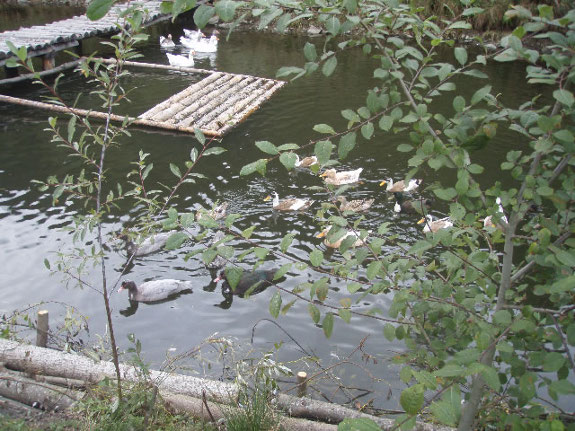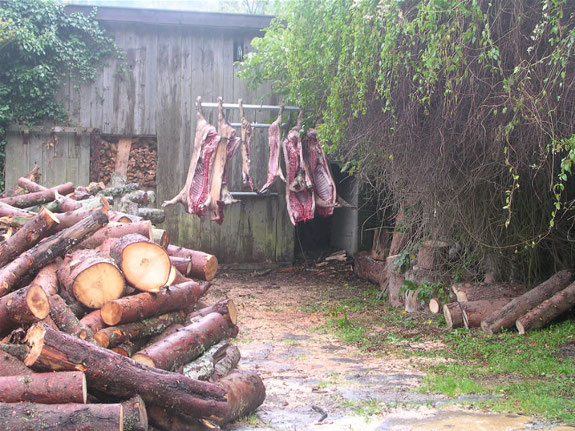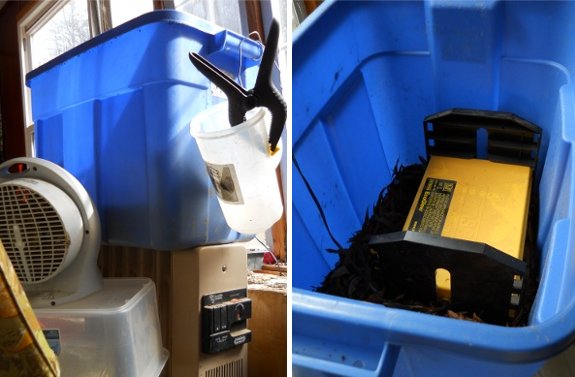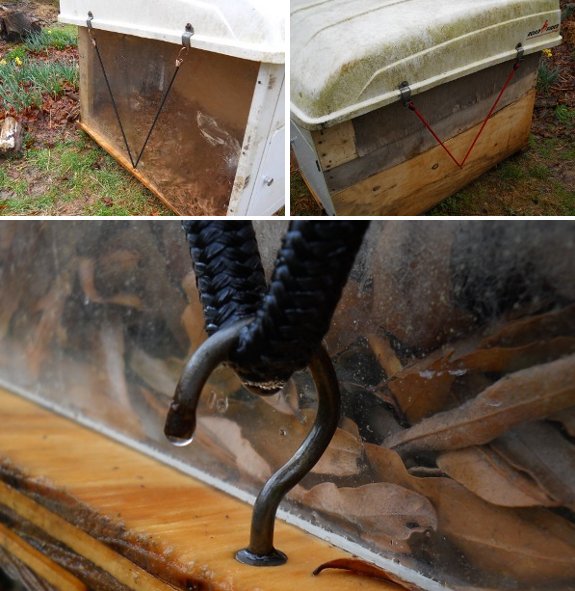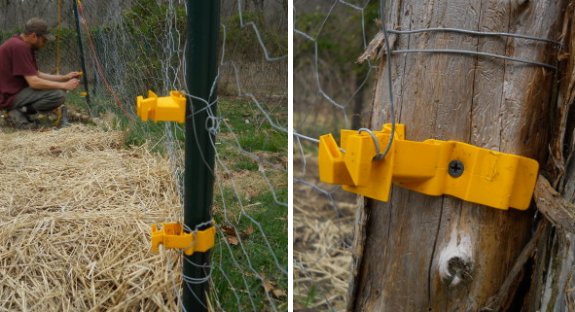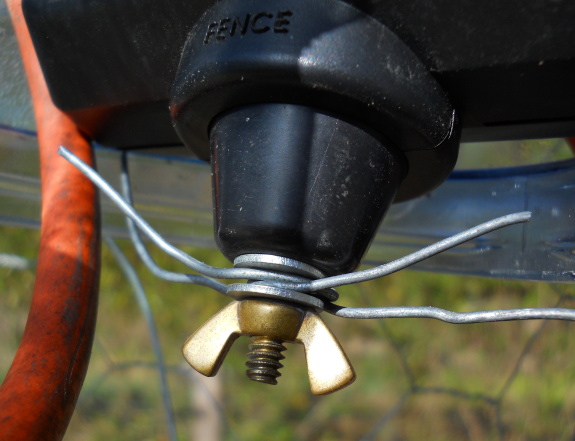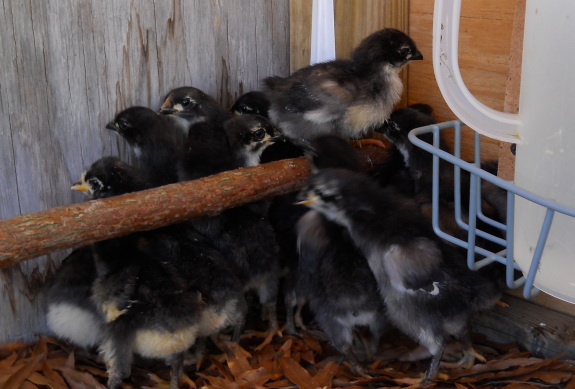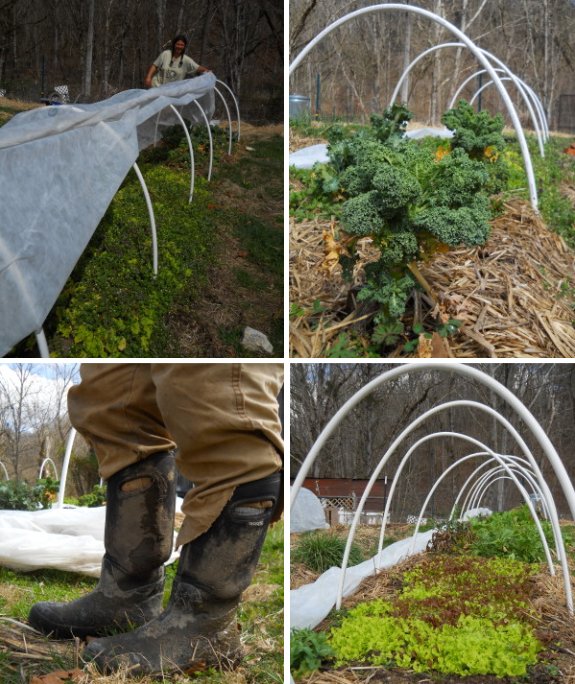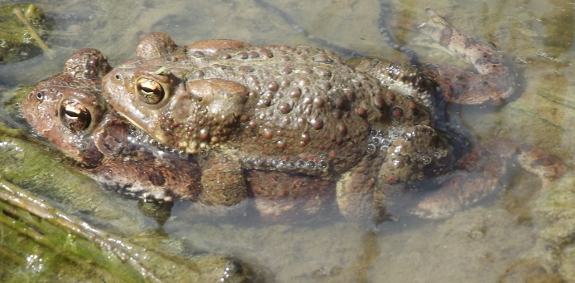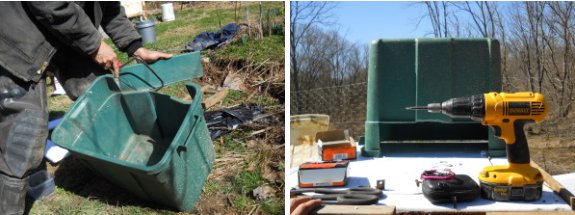
archives for 03/2012
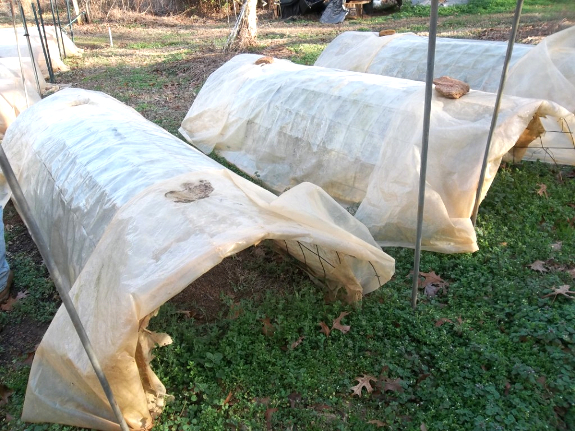
Joy wrote in recently to
tell me about an alternative quick
hoop design she'd
seen while touring a nearby farm. She wrote:
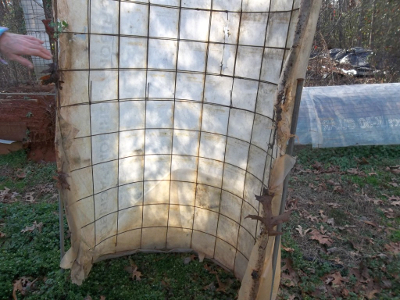 Neither had I, so I thought I
should share the design. It looks like the structure of the hoops
comes from remesh with metal pipes along the bottom.
Neither had I, so I thought I
should share the design. It looks like the structure of the hoops
comes from remesh with metal pipes along the bottom.I'm a bit afraid of the scratch factor from working with remesh, but I think the design has merit as a jumping off point for further experiments. If you try it out, I'd be curious to hear what you think of this alternative. And, as you spread the idea, be sure to credit it back to Steve Whiteman at Trillium Farms who can be reached at stevesmicrogreens@gmail.com.
Our chicken waterer prevents day old chicks from
drowning and gets them off to a healthy start.
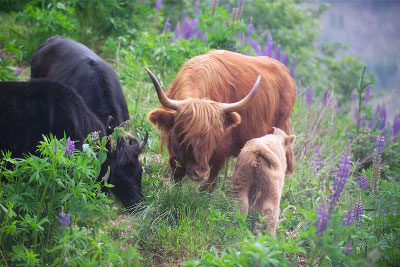 Sepp Holzer raises cattle,
bison, yaks, water buffalo, ducks, and chickens on his farm, but his centerpiece
animal is clearly
the pig. His swine are nearly self-sufficent, and also help out
by eating spoiled fruit in the orchard, increasing plant diversity by
creating small patches of bare ground, and regulating the snail
population. Holzer scatters feed on the ground when he wants the
soil loosened, and his pigs till that specific patch of earth.
And, of course, they provide meat.
Sepp Holzer raises cattle,
bison, yaks, water buffalo, ducks, and chickens on his farm, but his centerpiece
animal is clearly
the pig. His swine are nearly self-sufficent, and also help out
by eating spoiled fruit in the orchard, increasing plant diversity by
creating small patches of bare ground, and regulating the snail
population. Holzer scatters feed on the ground when he wants the
soil loosened, and his pigs till that specific patch of earth.
And, of course, they provide meat.
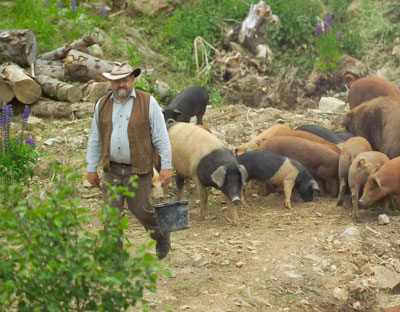 Holzer's pigs (and other
livestock) live in rotational paddocks that encompass his entire
farm. So the pigs move through the vegetable garden when it's
fallow, through the orchard to clean up windfalls, and
through the green
manure areas busy
improving the soil.
Holzer's pigs (and other
livestock) live in rotational paddocks that encompass his entire
farm. So the pigs move through the vegetable garden when it's
fallow, through the orchard to clean up windfalls, and
through the green
manure areas busy
improving the soil.
The pigs are stocked at
a density of about one to five pigs per acre, and are allowed to do a
moderate amount of damage before moving to the next paddock.
Holzer ensures that perennial tubers like Jerusalem artichokes aren't
entirely dug up by swine snouts, and finds that pig action spreads
smaller tubers around so that the plants actually expand before the 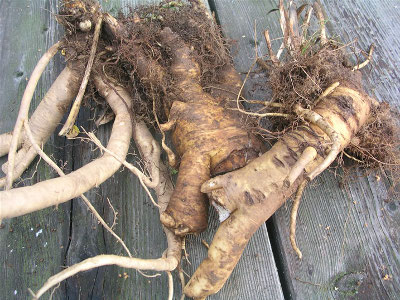 livestock come through
again. In the vegetable garden, he makes sure to leave lots of
crops unharvested at the end of the year, including beets, carrots,
turnips, cabbage, and potatoes, so that the pigs have something to eat
during the winter. And after the pigs leave a paddock, Holzer
seeds bare ground with green manure crops, tree seeds, or vegetables.
livestock come through
again. In the vegetable garden, he makes sure to leave lots of
crops unharvested at the end of the year, including beets, carrots,
turnips, cabbage, and potatoes, so that the pigs have something to eat
during the winter. And after the pigs leave a paddock, Holzer
seeds bare ground with green manure crops, tree seeds, or vegetables.
For those of you who
want to follow along at home, the trick to making sure that pigs
don't create a moonscape is variety choice and plenty
of space. Holzer's favorite breeds are Mangalitza, Swabian-Hall,
Duroc, and Turopolje, heritage breeds that may or may not be available
in the United States.
| This post is part of our Sepp Holzer's Permaculture lunchtime series.
Read all of the entries: |
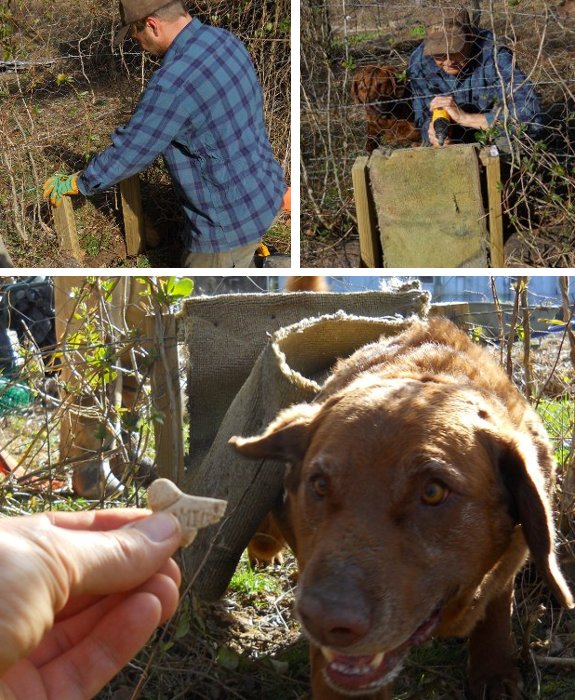
There's a small piece of 1x1
attached to the bottom edge of the carpet
for weight.
We will soon find out if
chickens are smart and or strong enough to push through.
Lucy figured it out in 10
minutes once we involved a chunk of Milk Bone.
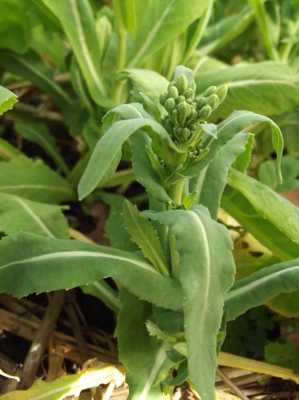 When
we started eating our Hakurei turnips in November, Daddy admonished me, "Don't
eat the turnips, eat the greens all winter long." So I left them
alone to see what would happen.
When
we started eating our Hakurei turnips in November, Daddy admonished me, "Don't
eat the turnips, eat the greens all winter long." So I left them
alone to see what would happen.
I was disappointed when
my turnips didn't put out many more leaves, but that's to be expected
since our Persephone
Days were beginning
by the time I cut the turnip tops the first time. Then, this
week, I discovered the real treat from overwintering turnips ---
"turnip raab" (aka "almost broccoli raab").
Despite the name,
broccoli raab is actually most closely related to turnips. Also
known as rapini, the vegetable is grown primarily for the unopened
flower buds, which can be cut repeatedly and which taste a bit like
broccoli. I haven't had good luck with broccoli raab in the past
--- it seems to bolt quickly and barely give me much of a harvest ---
so I stick to real broccoli.
That said, the flower
buds on my turnips were delicious, and the plants seem to be following
the lead of their relatives by sending out side shoots once I cut the
main head. 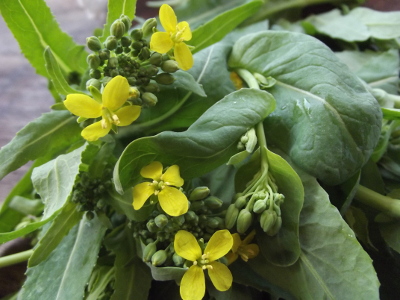 We've been eating bolted
mustard buds for a few weeks now, but the turnip buds are clearly a cut
above, with thicker stalks that don't go woody as quickly.
We've been eating bolted
mustard buds for a few weeks now, but the turnip buds are clearly a cut
above, with thicker stalks that don't go woody as quickly.
The moral of the story
is --- if you have overwintering turnips, go out and check on them now
for some bonus broccoli raab. The buds are best before they open,
but even young flowers like this are pretty tasty when you saute with
some mustard leaves and a bit of balsamic vinegar and peanut oil.
Whatever you do, don't pull out the bolting plants and consider them a
loss!
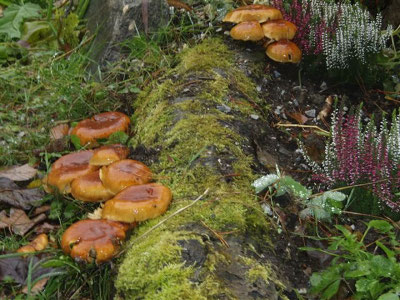 Sepp
Holzer's book has a whole chapter on growing edible mushrooms, which
helped me realize that he was probably the one who came up with the
ideas of mushroom
totems and notching
logs for easy inoculation. He also has the
following helpful tips for the permaculture mushroom keeper:
Sepp
Holzer's book has a whole chapter on growing edible mushrooms, which
helped me realize that he was probably the one who came up with the
ideas of mushroom
totems and notching
logs for easy inoculation. He also has the
following helpful tips for the permaculture mushroom keeper:
- Inoculate most logs ASAP, but wait to inoculate stumps until they stop resprouting. (I'll bet this is why neither of my stumps have produced fruit --- the living tree probably killed off the invading fungi.)
- Propagate most mushrooms by spawn, but use spores with woodtufts and enoki. Just place ripe caps on the end of moist, newly cut logs and the fungi will colonize them. However, spore propagation takes much longer than vegetative propagation, even among the mushroom species that handle the process well.
- To plug inocolution holes quickly when you're out in the woods, just stick in a twig of the right size and cut off the excess.
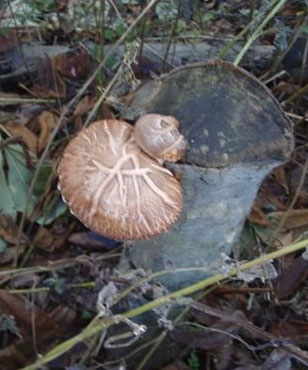 When inoculating logs with
notches, cut more than half the diameter of the log, fill it with
spawn, and cover the wound with plastic sheeting or adhesive tape.
When inoculating logs with
notches, cut more than half the diameter of the log, fill it with
spawn, and cover the wound with plastic sheeting or adhesive tape.- Rather than sticking mushroom totems in the ground right away, expedite colonization by pushing all of the logs together and covering them with leaves and jute bags. Once fungi have grown through the logs, you can sink them a third of the way in the ground in the direction that the tree grew for low-work fruiting.
- Onion bags full of ripe mushrooms can be hung in trees to spread
spores throughout your woodland.
Although his mushroom
chapter is only twenty pages long, it's one of the best primers I've
seen for homesteaders who want to incorporate mushrooms into their
ecosystem in the easiest ways possible.
| This post is part of our Sepp Holzer's Permaculture lunchtime series.
Read all of the entries: |
Our new Eco-Glow chick
brooder works great, but
it needs some help on cold, wet mornings like today.
The above configuration is
full of possible hazards, but not a terrible solution if you can
control any possible delinquent
cats that might be in the vicinity.
I was going to include a
picture of the first new chick, but I guess he's camera shy.
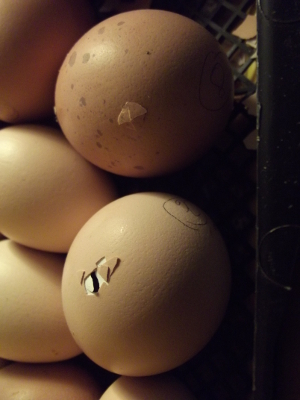 I
was totally unprepared for our first hatch of the year, for a couple of
reasons. First, our 2011 chicks never seemed to even consider
hopping out of their shells until day 22, which I now figure may be due
to our hatching
eggs being weakened
when they were jostled around by the postal service.
I
was totally unprepared for our first hatch of the year, for a couple of
reasons. First, our 2011 chicks never seemed to even consider
hopping out of their shells until day 22, which I now figure may be due
to our hatching
eggs being weakened
when they were jostled around by the postal service.
Which is all a long way of saying --- I thought I had all day Friday to
get the little indoor brooder ready for chicks so that I could be
prepared for a hatch to begin Saturday afternoon. The tupperware
container was outside, wet and dirty, and the leaves I planned to use
for bedding were still a bit damp.
Second, by this stage of
the winter, I've gotten acclimated to mild cold. Most
of this past week, overnight temperatures only dropped into the
forties, and
I woke to a trailer around 50 degrees Fahrenheit. It hardly
seemed
worth lighting a fire since my morning walk with Lucy warmed my blood
enough to tide me over until the sun came through the trees and heated
the trailer to summer levels. But chicks are less resilient (and
our brooder is only rated down to 50 degrees Fahrenheit with bone dry
chicks and bedding).
So our first chick of
2012 hatched into a household scurrying around to prepare his
brooder. I set Mark on cleaning out the brooder while I watched
the tiny ball of fuzz push its way out of the shell.
Last year, I got into
the habit of moving chicks out of the incubator nearly immediately
rather than waiting until they dried off fully since I didn't like
newly hatched chicks rolling the unhatched eggs around. So, half
an hour after hatch, I plucked out our hatchee and popped him under the
Brinsea
Ecoglow Brooder.
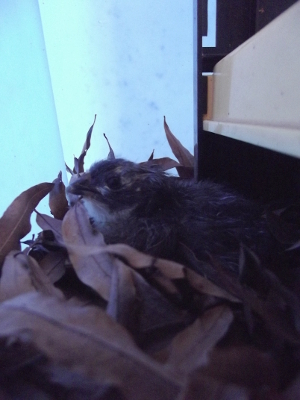 Peep, peep, peep. The peeping got worse
and worse until I was tearing out my hair. I thrust the chick
back into the incubator, lit a fire in the woodstove, and turned on a
space heater, all at the same time. (At least the chick didn't
end up in the stove.) Then, half an hour later, I tried Operation
Chick Move again.
Peep, peep, peep. The peeping got worse
and worse until I was tearing out my hair. I thrust the chick
back into the incubator, lit a fire in the woodstove, and turned on a
space heater, all at the same time. (At least the chick didn't
end up in the stove.) Then, half an hour later, I tried Operation
Chick Move again.
Peep, peep, peep. Boy, that chick
wasn't a happy camper, and neither was I. With some trepidation,
I set the brood box up on top of the space heater and ran to get Mark's
input.
Peep,
peep, PEEP. The chick was still
yelling his head off, so Mark
added another space heater to increase the temperature inside.
Peep, peep, peep, peeeep.
Finally, peace and quiet! Lesson learned --- homegrown eggs might
pop open on day 20 and early spring chicks need some extra heat beyond
the Brinsea brooder during the drying off period. And here I
thought I was such an old hand that there wouldn't be any drama during
the hatching period. Stay tuned to hear the stats on the rest of
the hatch.
Two bungee cords was what it
took to make the new chick
coop convertible.
I've been using these mug
hooks on several projects lately.
They're self starting and
easy to install. I try to keep a package on hand for any emergency chicken projects.
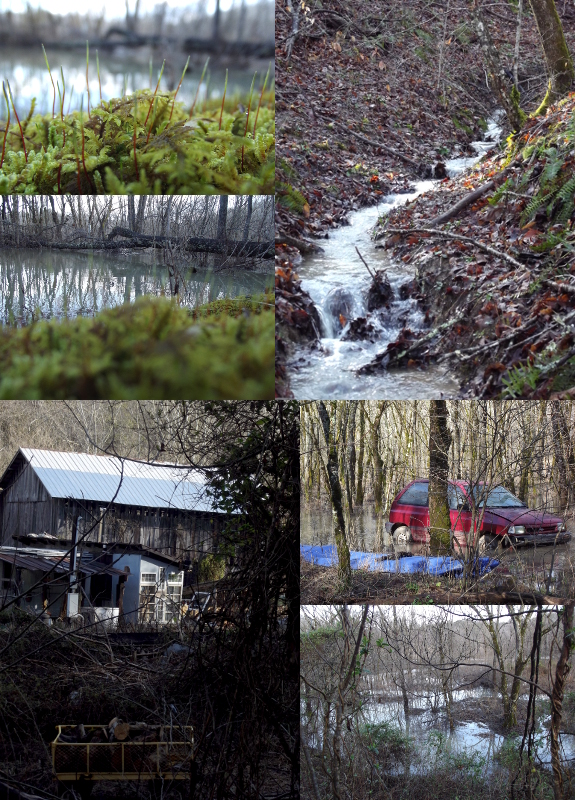
We're flooded in and our
roofing
tin is partially
submerged halfway back through the floodplain. But talking about
that isn't nearly as much fun as pondering ebook ideas.
I told you two weeks ago
that working
hard to make Weekend Homesteader a text worthy of print publication had
worn me out...but
that I expected to be gungho about writing again by the end of the
month. Sure enough, last week I started dreaming up ebook ideas
as I weeded the beds to prepare for planting spring greens. Here
are the top contenders so far:
- Garden Ecology ---
Several books cover the identification of beneficial and pest insects,
but I would delve deeper, walking you through identifying large and
small critters, fungi, and plants that live in your garden but don't
cause enough problems to end up on the list of garden bandits.
With chapters on producers, decomposers, predators, and pollinators,
you'd learn about food webs and nutrient cycles and figure out how to
manage your garden to keep a healthy ecosystem in place.
Estimated length: 4 ebooks with 30 to 40 pages each.
- The Permaculture Chicken
--- This intermediate guide to chickens starts where most books leave
off and helps you turn your flock into a more self-sufficient and
integrated part of the homestead. Learn the pros and cons of
housing your chickens in tractors, pastures, or free range; choose
chicken varieties good at rustling up their own grub; and manage a
small-scale pasture of annuals and perennials that keeps your flock
healthy. A chapter on incubation will make raising your own
chicks less traumatic for newbies, while tips on cooking with heirloom
chickens will help you make the transition from supermarket chicken
breasts to more wholesome fowl. Finally, I'll give you ideas for
using chickens as more than mere producers of eggs and meat --- their
pastures can keep out deer, their manure can feed the garden, and the
chickens themselves can scratch cover crops into the ground.
Estimated length: 6 ebooks with 30 to 40 pages each.
- No-till Cover Crops ---
This short guide reveals the pros and cons of the three main types of
cover crops --- small grains, legumes, and everything else --- and
helps you choose varieties that match your gardening style. Learn
the easiest ways to plant and kill cover crops without tilling the soil,
then time your planting to fit into fallow periods you didn't even know
existed in your garden year. Estimated length: 1 ebook with 30 to
40 pages.
You did such a good job
of choosing a
winner
last year that I'm going to let you weigh in on this year's project as
well. Which of these ideas sounds like something you'd like to
hear me
write about at length? Is there another topic you wish I'd write
about instead? Thanks in advance for your feedback!
The creek is still too high
to cross wearing hip waders.
Not a problem if you're part
of the dedicated roofing team working on our barn.
They got the tin moved
back and all but one panel installed.
We are both very impressed
with their level of hustle!
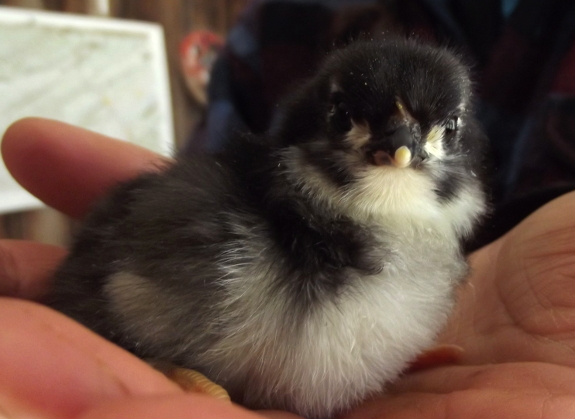
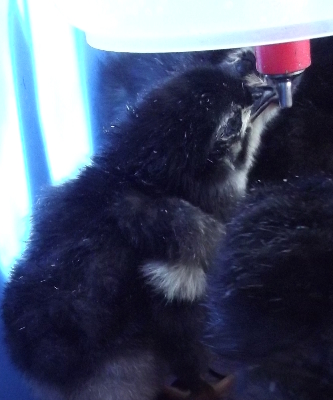 Rather
than braving
the raging creek to
carry in the milled grain we bought for our chicks, I've been
tantilizing their budding appetites with hard-boiled eggs.
Technically, I could have just waited until the flood waters receded
--- after all, chicks can go for three days without food or water after
birth. But they'd already figured out how to drink from
their chicken waterer within hours of landing in
the brooder, so I figured they could handle some solids as well.
Rather
than braving
the raging creek to
carry in the milled grain we bought for our chicks, I've been
tantilizing their budding appetites with hard-boiled eggs.
Technically, I could have just waited until the flood waters receded
--- after all, chicks can go for three days without food or water after
birth. But they'd already figured out how to drink from
their chicken waterer within hours of landing in
the brooder, so I figured they could handle some solids as well.
I can't help wondering
whether we couldn't get chicks off to an even better start by feeding
them real food for the first few weeks, while their appetites are small
enough that the fancy foods won't break the bank (or wear us out
foraging). I've seen a mother hen pecking apart worms for her day
old offspring, which makes me think animal products are the way to go.
What's your favorite
homemade chick starter feed? Have you ever raised chicks on
non-storebought feed?
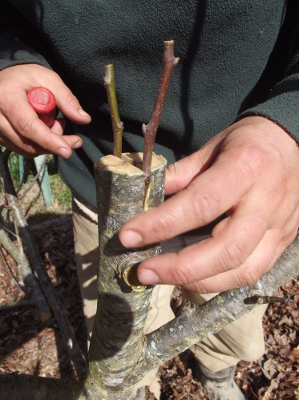 This
week's lunchtime series is a little unusual. I usually either
titillate you with a topic I feel (semi-) expert on, or highlight the
most interesting facts from a book. But topworking my pears was
so educational (and photo rich) last week that I decided to bring you
along and let you walk through the process with me.
This
week's lunchtime series is a little unusual. I usually either
titillate you with a topic I feel (semi-) expert on, or highlight the
most interesting facts from a book. But topworking my pears was
so educational (and photo rich) last week that I decided to bring you
along and let you walk through the process with me.
I have to admit, though,
that I'm far from an expert at grafting.
I've taken a couple of workshops and read a few websites and chapters
on the topic, but I'm still very much learning. I'm also
experimenting with ways to graft without buying the tools and
supplies most grafters think they need since I figure if I went out to
find the official
tools for every project I wanted to try on the homestead, we wouldn't
have room for them even in our huge barn.
Which is all a long way
of saying that I hope those of you with more
experience will chime in this week and point me in a different
direction if you think I'm going astray. And, as for the rest of
you with even less experience than me, take this series with a grain of
salt --- this is the way I did it, not necessarily the way you should.
| This post is part of our Grafting Experiment lunchtime series.
Read all of the entries: |
Need some foam,
but don't know how to get an 8 foot by 4 foot sheet in your car?
You could cut the sheet into
sections in the parking lot, or get one of these panel kits for about 6
dollars.
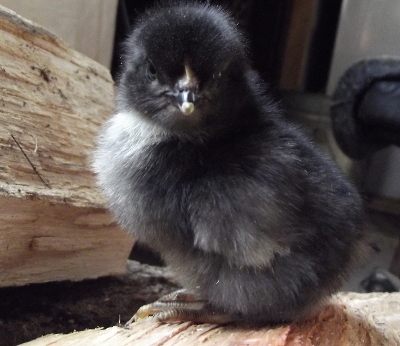 We've had a strangely
elongated hatch this time around, which I think is due to cold weather
exacerbating differences
in temperature within the incubator. But it's hard to
complain when the final count is 18 living chicks, two yolkers (which
were either infertile or died very young), and one fully formed but
dead in the shell chick. (It's possible even that last guy might
have hatched, but I thought for sure he was dead when he hadn't pipped
by the end of day 23!)
We've had a strangely
elongated hatch this time around, which I think is due to cold weather
exacerbating differences
in temperature within the incubator. But it's hard to
complain when the final count is 18 living chicks, two yolkers (which
were either infertile or died very young), and one fully formed but
dead in the shell chick. (It's possible even that last guy might
have hatched, but I thought for sure he was dead when he hadn't pipped
by the end of day 23!)
Most of the chicks have australorp
fathers and mothers, but two have sussex and seven have marans
mothers. You know how humans take one look at the squashed up
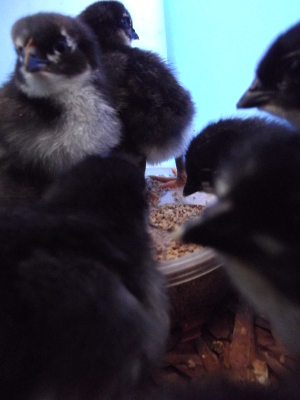 face of a newborn baby and immediately say it looks like the father
(seldom the mother)? Well, I thought the same of our little
hybrids at first. But soon I noticed that some appeared blacker
than others, making me think those are the maransXaustralorp
chicks. I wonder if I'll see signs of hybrid vigor when the time
comes to weigh then eat them?
face of a newborn baby and immediately say it looks like the father
(seldom the mother)? Well, I thought the same of our little
hybrids at first. But soon I noticed that some appeared blacker
than others, making me think those are the maransXaustralorp
chicks. I wonder if I'll see signs of hybrid vigor when the time
comes to weigh then eat them?
(As you can tell, the
creek went down enough that I could bring in the chick feed. Our
youngsters thought the milled grain was almost as interesting as hard-boiled
egg yolks, but they
spilled it pretty badly until I made a homemade feeder. More on
that eventually if it works.)
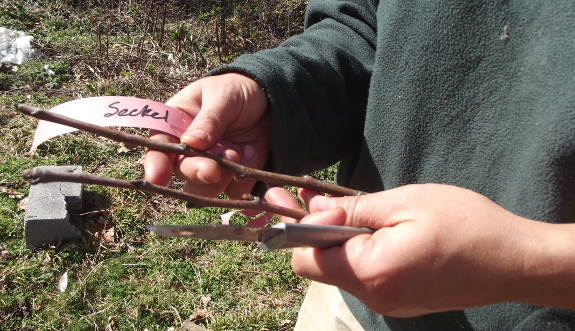
My first step after
deciding to topwork my two pear trees was to
find scionwood. I wanted to try specific varieties, so I ordered
some from Burnt Ridge Nursery, but you can also get scionwood from a
neighbor's tree if you know you like the taste and habits of their
fruit varieties. The best scionwood is about the thickness of a
pencil, is from last year's growth, doesn't contain flower buds, and
does contain two or three leaf buds. Longer scionwood is fine,
and gives you some wiggle room in case you make the first cut wrong ---
you can always shorten it to three buds later.
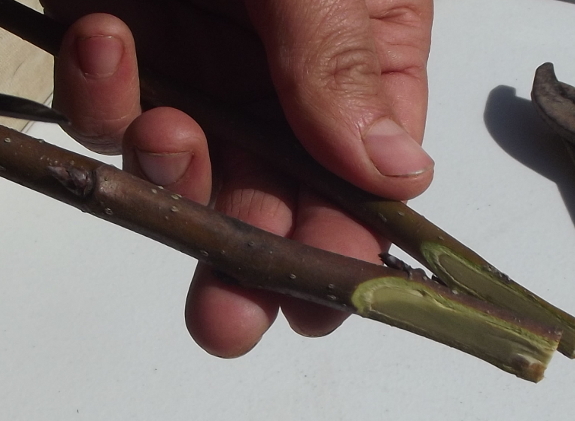
Although you should wait
to prepare your official scionwood until it's ready to go into place
(Thursday's post), raw beginners like me should practice first so we
become relatively adept at our cuts before working on the limited
scionwood. Grafting cuts should always be as straight as
possible, which means you should try to make them with a single cut
rather than "whittling" --- fixing incorrect cuts by making two or
three more cuts. The photo above shows some of my early practice
strokes --- you can see the curves that result from whittling.
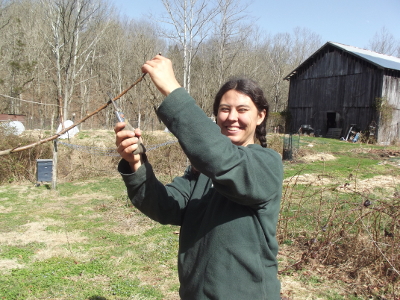 Luckily for me, I had plenty
of wood to practice on. I planned to cut the whole top off my two
small pear trees and insert new scionwood in a cleft graft, so nearly
all of the twigs on the tree were fair game.
Luckily for me, I had plenty
of wood to practice on. I planned to cut the whole top off my two
small pear trees and insert new scionwood in a cleft graft, so nearly
all of the twigs on the tree were fair game.
I actually practiced on
a little walnut tree I needed to cut out of the yard first, but soon
discovered that different trees' twigs behave very differently.
If you're going to graft a pear tree, practice on some pear twigs; if
you're going to graft an apple, practice on an apple.
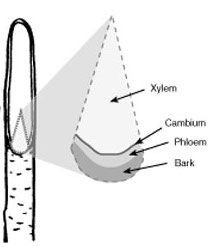
 So, what did I want my cuts
to look like? The easiest grafting cut is for a whip graft, where
you attach two twigs of the same diameter together. That kind of
graft simply requires a long straight cut so that the scionwood comes
to a point, as is shown in the drawing to the left.
So, what did I want my cuts
to look like? The easiest grafting cut is for a whip graft, where
you attach two twigs of the same diameter together. That kind of
graft simply requires a long straight cut so that the scionwood comes
to a point, as is shown in the drawing to the left.
For my cleft graft, I
needed to make a slightly more complex cut. I wanted to turn the
base of the scionwood into a wedge by making two angled cuts. To
complicate matters further, the wedge needed to be pie-shaped in
cross-section, with the side containing the lowest bud larger than the
other side of the twig. This sounds complex, but wasn't really
that hard to cut, once I wrapped my head around the goal.
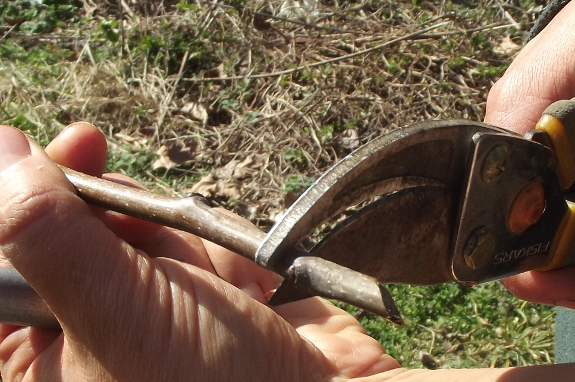
Time to start
cutting! Grafting teachers always warn you to make sure the buds
point up, which seems ludicrously obvious to me, but maybe folks not as
tuned into plants need to be told that? Once you turn your
scionwood right side up, decide which spot will be the bottom of your
cut. I learned the hard way that you won't get a nice, straight
cut if you try to go through a node (where the buds are), so I cut my
scionwood off just above a bud.
It's best if you also
choose a spot where the internode (length of wood between two buds) is
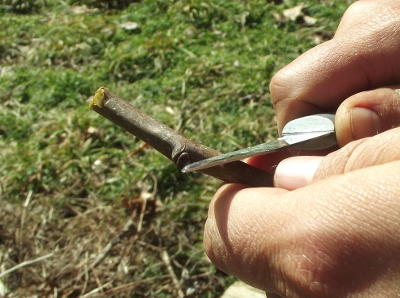 relatively long since your angled cut should be at least an inch long,
preferably 1.5 to 2 inches. Longer cuts give your scionwood a
better chance of merging with the growing tissue of the tree it's being
grafted onto.
relatively long since your angled cut should be at least an inch long,
preferably 1.5 to 2 inches. Longer cuts give your scionwood a
better chance of merging with the growing tissue of the tree it's being
grafted onto.
Now find a good sharp
knife (I used our chicken butchering knife, recently sharpened) and
make your first test cut. Remember, you don't want to whittle, so
you should create the wedge shape at the bottom of your piece of
scionwood in two quick cuts. Once you try it a time or two,
you'll see why I told you to practice on a twig you didn't care about.
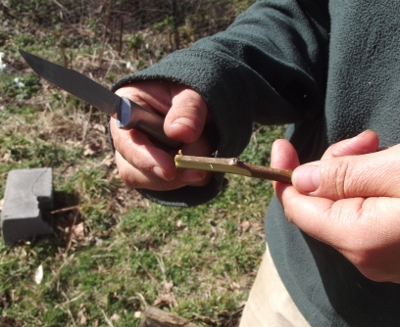 After making Mark stand
around in the sun and watch me whittle for about fifteen minutes, I
started to feel like my cuts were going more smoothly. Time
to move on to the next step --- preparing the tree to be grafted
onto. Stay tuned for tomorrow's post to learn tips in that
department.
After making Mark stand
around in the sun and watch me whittle for about fifteen minutes, I
started to feel like my cuts were going more smoothly. Time
to move on to the next step --- preparing the tree to be grafted
onto. Stay tuned for tomorrow's post to learn tips in that
department.
| This post is part of our Grafting Experiment lunchtime series.
Read all of the entries: |
We added 2 layers of foam to the floor of the chick
coop in an effort to retain more heat from the Eco-Glow brooder.
The plan is to use the above
Rubbermaid tub as a mini-enclosure for the brooder while inside the
chick coop.
Stay tuned to see if these
preparations will be enough to keep the new round of chicks warm and
happy.
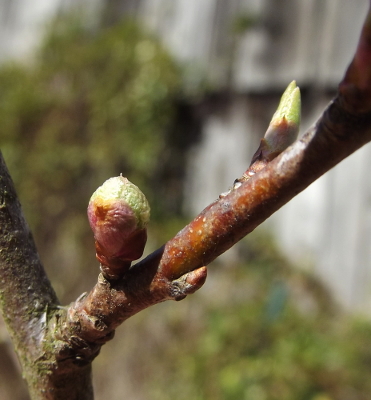 Can
you tell the flower buds from the leaf buds on your fruit trees?
The distinction is important if you prune in the winter, but it's also
handy to be able to guess whether your young trees are going to bear
fruit this year or not.
Can
you tell the flower buds from the leaf buds on your fruit trees?
The distinction is important if you prune in the winter, but it's also
handy to be able to guess whether your young trees are going to bear
fruit this year or not.
In general, flower buds
are fat and round while leaf buds are more pointy and less
significant. The differences really become obvious at this time
of year when the flower buds are swelling up in preparation for
opening, in contrast to leaf buds that are still dormant. (Well,
unless you're a plum, as is shown above, which tends to spit out leaves
at the same time it blooms.)
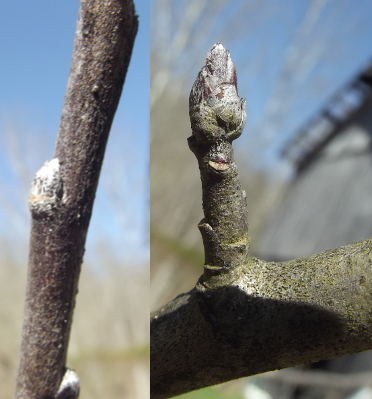 Apple
buds are a bit trickier, but share the same general theme. Most
apple varieties bloom on fruiting spurs, which are simply dwarfed twigs
sticking out the sides of your branches. You might find a single
flower bud (shown on the right) on a spur, or it might be an entire
cluster. The photo on the left shows an inconspicuous apple leaf
bud.
Apple
buds are a bit trickier, but share the same general theme. Most
apple varieties bloom on fruiting spurs, which are simply dwarfed twigs
sticking out the sides of your branches. You might find a single
flower bud (shown on the right) on a spur, or it might be an entire
cluster. The photo on the left shows an inconspicuous apple leaf
bud.
Pears buds are similar
to apples while peaches are similar to plums. Cherries fall
somewhere in between.
We got a slow start on
our apples, but our oldest tree (a Virginia Beauty planted three years
ago) seems to be covered with flower buds this year. Similarly,
our three year old Methley plum is also dotted with plump flower buds.
I'm trying hard not to
count my fruit before they ripen, though. I've learned from
experience that late
freezes can easily wipe out flower buds, and that young trees often
drop their flowers the first year rather than setting fruit. In
addition, since my Virginia Beauty may be the only apple in my orchard
who's ready to bloom this year, the precocious tree might not get
pollinated.
The plum might have
issues as well. When I bought the tree, it was marked as
self-pollinating, but now I'm seeing that Methley plums are Japanese
type plums and require pollinators --- I guess I'll see who's right
depending on whether we sink our teeth into juicy plum flesh this year
or not. Although it would be a bummer to have to wait another
three years to eat homegrown plums, I never mind an excuse to expand
our fruit selection.
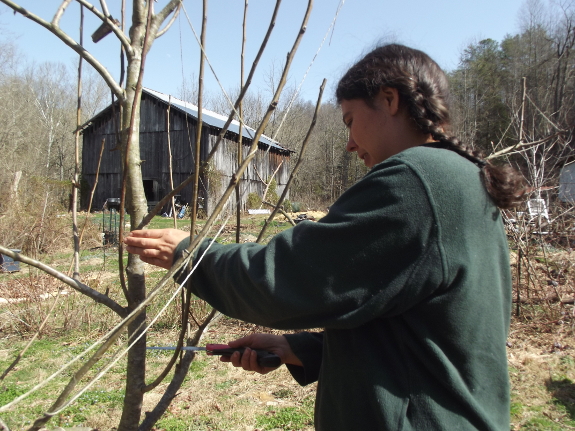
A previous post about topworking explained that my four year
old pears are small enough to graft all in one go. However, I've
also read that it can be tough for a tree of any size to suddenly lose all of its branches, so some
orchardists leave a few in place to shade the scionwood a bit so it's
not exposed to blazing sun while trying to get established. As a
result, I decided to cut into the main trunk just above the first pair
of limbs.
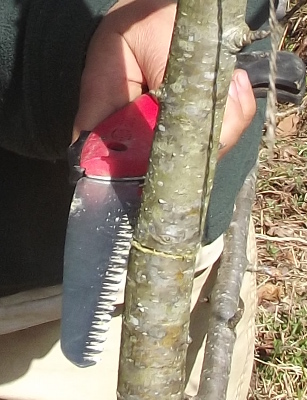 The
other factor to consider when preparing your tree to be grafted onto is
ensuring you make a very clean cut. The success of a graft
depends on the cambium, which is the thin layer of living tissue just
under the bark. So, if you cut a tree and it tears half the bark
off one side in the process, your grafts are going to be less
successful.
The
other factor to consider when preparing your tree to be grafted onto is
ensuring you make a very clean cut. The success of a graft
depends on the cambium, which is the thin layer of living tissue just
under the bark. So, if you cut a tree and it tears half the bark
off one side in the process, your grafts are going to be less
successful.
I worked around this
potential problem by cutting about halfway through the tree, then
coming around to the other side and cutting through the bark
there. When I finished my cut, the top fell off the tree without
damaging the bark at all. (By the way, these sharp
little saws are awesome for making precise cuts like this.)
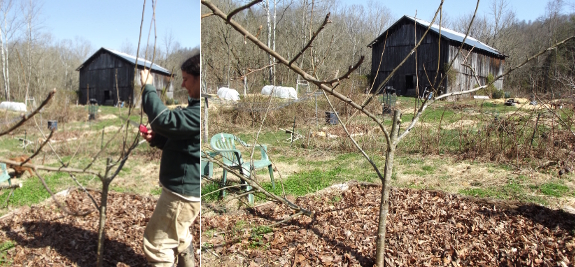
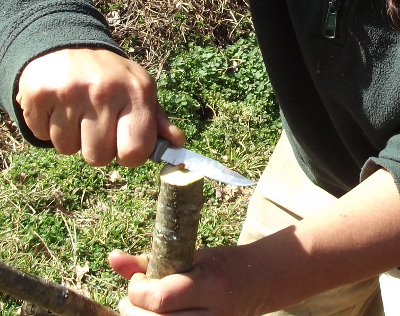 Timber!
Timber!
The final step in
preparing the tree to be grafted onto is to trim any irregularities
from the wood. One of my cuts came out perfect, and the other
needed just a tad of whittling with my sharp knife. Now the tree
was ready to accept scionwood and to be turned into a new variety.
| This post is part of our Grafting Experiment lunchtime series.
Read all of the entries: |
The new chick coop is ramped
up and ready for business.
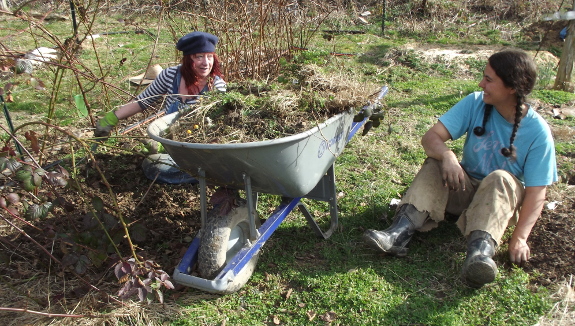
I've been lucky to have
a weeding buddy come over every week or two for the last couple of
months. Those problem perennials that I didn't quite remember to
weed in the last year? They're almost all ship shape! I
suspect that one more round of weeding will bring the last couple of
rows in line. Thanks, Anndrena!
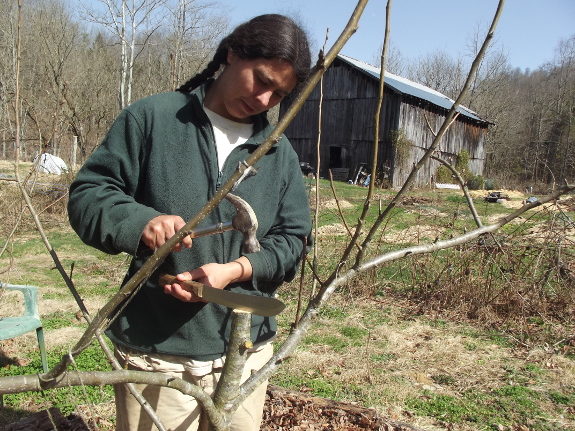
Now that I've cut
the top off of my young tree, I can insert the
scionwood. Step one is to slit the trunk of the tree vertically
for about two inches --- making the cleft.
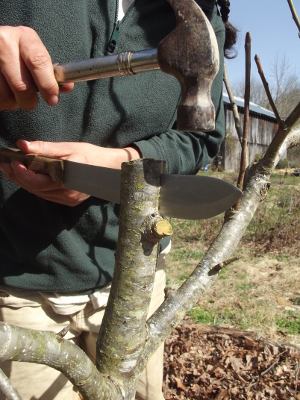
Orchadists have special
tools for cleft grafting, but I figured I could find everything I
needed between the kitchen and the toolbox. The small, sharp
knife shown below was too miniscule to do the job, but a big, dull
butcher knife combined with a hammer was just right.
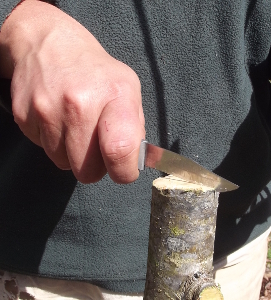
I hammered the big knife
into the center of the trunk, then pounded on the sides of the knife to
insert it a bit deeper. On my second tree, I didn't make the slit
quite so deep, and found it more difficult to insert the scionwood, so
be sure to make your slit big enough the first time.
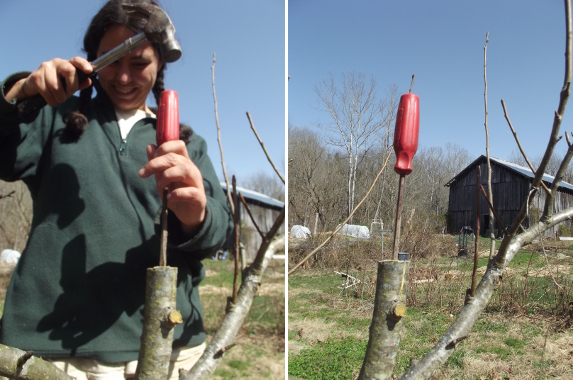
The next step is to
widen the cleft using a wedge. Again, professionals use a special
tool for this procedure, but a screwdriver pounded in easily and worked
great.
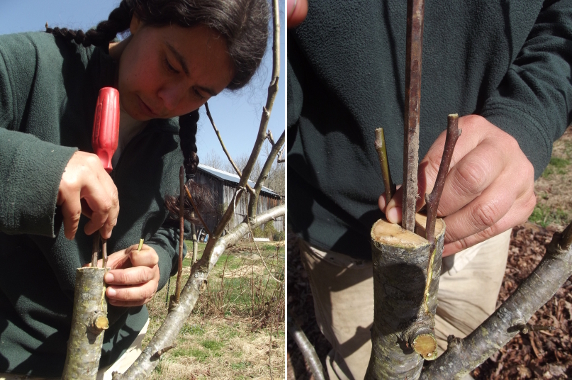
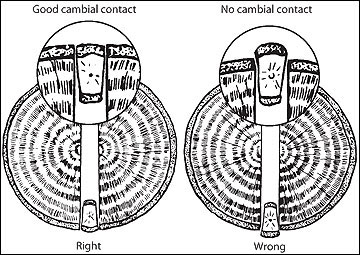 Cut
the scionwood as described previously, then insert two pieces, one
on
each side of the wedge. If the cleft isn't quite as open as you'd
like, you can rotate the screwdriver slightly to widen the gap.
Cut
the scionwood as described previously, then insert two pieces, one
on
each side of the wedge. If the cleft isn't quite as open as you'd
like, you can rotate the screwdriver slightly to widen the gap.
Scionwood insertion is
the trickiest and most important part of the whole process, so take a
few minutes to make sure you're doing it right. The diagram below
shows a cross section through a piece of scionwood, illustrating the
layers of different kinds of cells that make up a twig.
 You can think of the cambium
as the stem cells of the plant world --- the cambium cells are still
physiologically flexible and can grow together with the cambium of a
different tree. The cambium is relatively easy to see if you have
good eyes since it tends to be bright green. Your goal is to make
sure the cambium of your scionwood lines up with the cambium of the
tree you're grafting onto.
You can think of the cambium
as the stem cells of the plant world --- the cambium cells are still
physiologically flexible and can grow together with the cambium of a
different tree. The cambium is relatively easy to see if you have
good eyes since it tends to be bright green. Your goal is to make
sure the cambium of your scionwood lines up with the cambium of the
tree you're grafting onto.
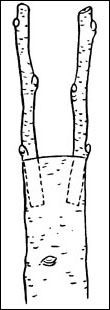
Your gut reaction will
probably be to try to make the scionwood fit flush against the side of
the tree being grafted onto, but that's not quite right. As a
tree grows, it not only expands the xylem (the woody part in the
center), but also the phloem (which turns into the bark). So, the
cambium is going to 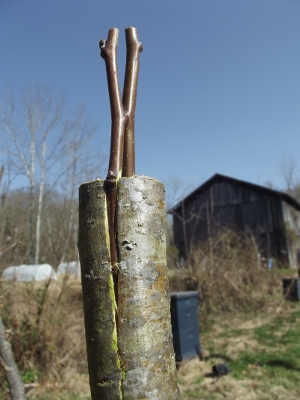 be a little deeper into the
older tree being grafted onto than it is on the little twig of
scionwood. That's why most people recommend making sure your
scionwood is slightly indented as you look at your graft from the side.
be a little deeper into the
older tree being grafted onto than it is on the little twig of
scionwood. That's why most people recommend making sure your
scionwood is slightly indented as you look at your graft from the side.
One way to hedge your
bets is to insert your scionwood at a slight angle, as is shown in the
drawing to above, so that the cambial layers intersect somewhere. This type of angled
scionwood placement won't give you as strong a connection, but is
better than nothing if you're not sure you'll get your cambial layers
lined up otherwise.
One last note on
scionwood placement (which you really should have considered when
making your cuts) --- most sources recommend that the first bud on your
scionwood sits just above the top of the tree being grafted onto.
If you had extra scionwood length, now is a good time to cut each one
down to two or three buds. Stay tuned for tomorrow's post, in
which I'll explain how to seal the cut surfaces.
| This post is part of our Grafting Experiment lunchtime series.
Read all of the entries: |
Lucy is still making holes in
the chicken pasture fence.
Arghhh...
When I tested the electric
fence line we installed today it seemed a little weak. I first
thought we might be reaching the limit of distance, but the
instructions say it should go up to 1500 feet.
I'm thinking I may have not
tightened down the wing nut enough where the two wires attach. Either
that or maybe the unit is suffering some sort of power decline?
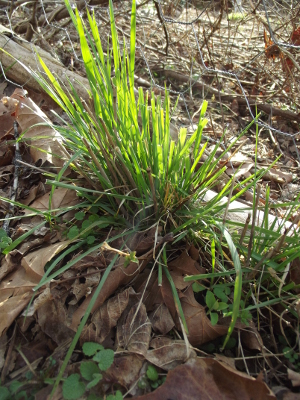 Even though chickens get most
of their nutrition from insects and
seeds, tender young plants provide lots of vitamins and minerals (and a
surprising amount of protein). That's why I was thrilled to
notice grasses beginning to grow in several spots around the farm in
the last week.
Even though chickens get most
of their nutrition from insects and
seeds, tender young plants provide lots of vitamins and minerals (and a
surprising amount of protein). That's why I was thrilled to
notice grasses beginning to grow in several spots around the farm in
the last week.
One of our newest
pastures is under the trees where "normal" grasses seldom grow.
However, a few clumps of bunchgrasses are evident. The chickens
ate them down to nubbins, but this clump has already started to regrow
in the last week since the chickens were turned out of the
pasture. Does anyone have a clue what kind of grass this might be?
I'm relatively sure that
the tender-leaved grasses that pop up in closely mown parts of our yard
and in the treeless pastures are bluegrass. Bluegrass feels
delightful to bare feet, and 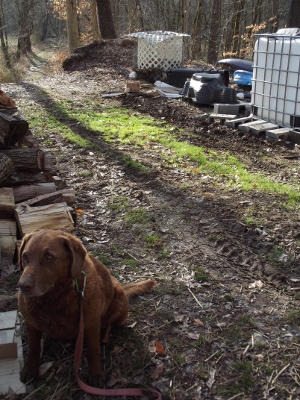 also stays tender enough for
chickens to enjoy even in the summer, so I'm pleased it sprouts
anywhere we open up the canopy and mow regularly.
also stays tender enough for
chickens to enjoy even in the summer, so I'm pleased it sprouts
anywhere we open up the canopy and mow regularly.
New bluegrass leaves
started to push up through the dead brown litter in the garden aisles a
week or so ago, but regrowth started sooner in more protected
areas. For example, this patch of green is underneath where we
usually park the truck --- I assume that big old hunk of metal
mitigated some of winter's cold and let the grass grow faster.
But the most vigorous
early spring grasses aren't in our cultivated areas at all. I
looked out across the floodplain on Monday and noticed a huge patch of
green in what we fondly term "the alligator swamp" --- a waterlogged
oxbow off our creek.
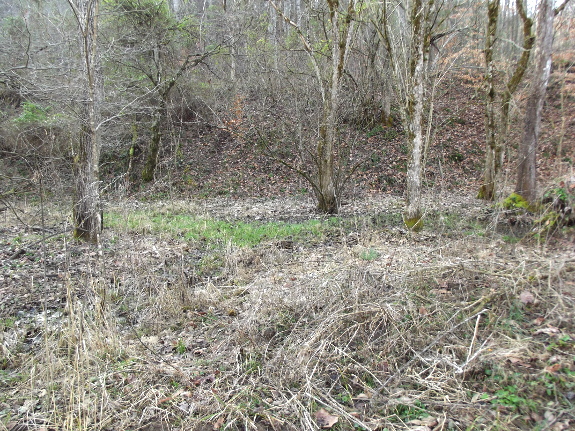
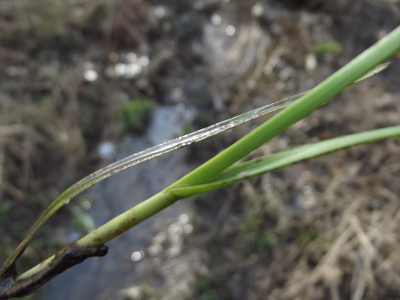 I don't know if these
water-loving grasses are a species that always gets a jumpstart on
spring, or whether the thermal mass of the water is responsible for the
vibrant greenery. But maybe that explains why the chickens have
been hanging out in the damp area on the far side of the barn rather
than following the sun in the early morning the way they did a few
months ago.
I don't know if these
water-loving grasses are a species that always gets a jumpstart on
spring, or whether the thermal mass of the water is responsible for the
vibrant greenery. But maybe that explains why the chickens have
been hanging out in the damp area on the far side of the barn rather
than following the sun in the early morning the way they did a few
months ago.
Learning the patterns of
grass growth is essential to proper pasturing. For example, I'm
planning all of my broilers to hit the ground running just as the grass
is reaching its peak. However, I've still got a long way to go
before I thoroughly understand our sod, and grass species ID is
clearly near the top of the to-learn list. Has anyone tried out
various grass field guides and settled on one that helps from a
pasturing point of view?
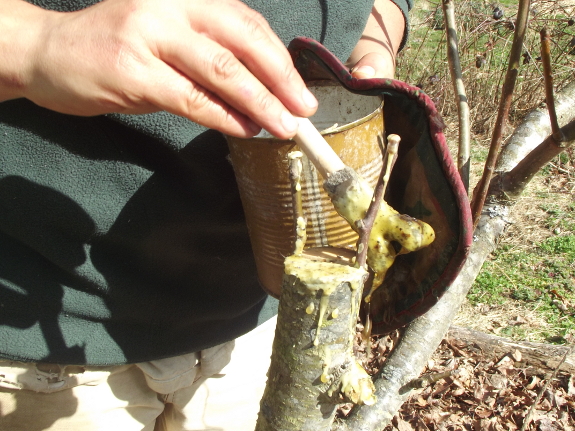
The final step in any
grafting project is to seal all cut surfaces so they don't dry out
before they're able to heal. Professionals buy grafting tar or
parafilm, but I wanted to try some materials I already had on hand.
The trick with using
beeswax or some other homegrown compound to seal your grafting cuts is
that hot wax can damage the cambium of the tree. I opted to dab
on mostly melted beeswax, figuring it wouldn't hurt the tree as long as
it didn't burn my finger when I dripped a bit of melted wax on my
skin. This is the most experimental part of my project, though,
since no one else seems to use straight beeswax to seal their wounds.
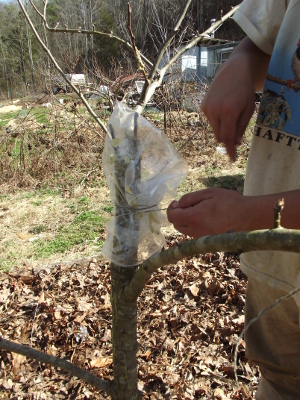 One recipe for making your
own sealing wax includes 1 part raw linseed oil, 2 parts beeswax, and 4
parts powdered rosin. Someone else kneaded mineral oil into hobby
clay to make a sealing compound. I suspect both of these
compounds would be flexible enough that you could paint them on cold,
which would delete the potential heat problem.
One recipe for making your
own sealing wax includes 1 part raw linseed oil, 2 parts beeswax, and 4
parts powdered rosin. Someone else kneaded mineral oil into hobby
clay to make a sealing compound. I suspect both of these
compounds would be flexible enough that you could paint them on cold,
which would delete the potential heat problem.
No matter which compound
you use, you want to cover the tips of each piece of scionwood, then
liberally dab wax or tar on the top and sides of the cleft tree
trunk. Do your best to be more careful than I was and not cover
up any of the precious buds on the scionwood --- I had to pick a bit of
wax off with my fingernails.
Some sources suggest
tying a plastic bag over the top of the grafted area when you're done
for an added layer of protection. It sounds like you can use
carpenter's glue to seal the graft as long as you top it off with
aluminum foil and then a plastic bag. However, plastic bags
require more work since you'll need to keep them out of direct sunlight
so they don't heat up, and then you have to take the bag off once the
scionwood starts to grow. I'm thinking of deleting the plastic
bags, actually --- what do you think?
Despite taking five long
posts to tell you about this, I performed a cleft graft on two pear
trees in less than an hour, counting all of my practice cutting
time. So don't be scared away from the process. I'll report
back this summer as our scionwood (hopefully) starts to grow.
| This post is part of our Grafting Experiment lunchtime series.
Read all of the entries: |

So I went out and tightened
down the wing nut where the two wires meet and at first I didn't notice
any change....just a low level prickly feeling when you touched
it....and then a few minutes later while I was taking a few pictures it
must have had time to charge up or something because ZOWWIE!!!!....the
darn thing jolted me so hard I dropped the camera, which softly landed
in a bed of straw mulch.
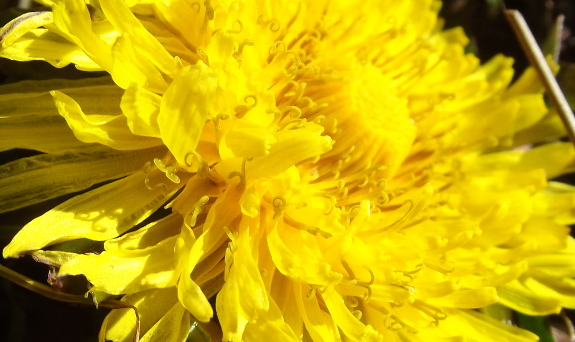
My mom sent me an email
that tickled my fancy a week or two ago:
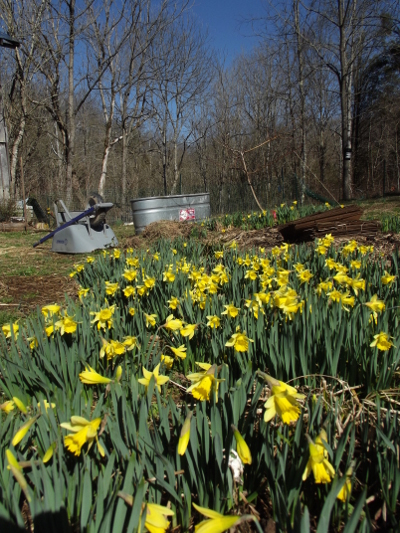 She
got interested in the idea of dandelions as an indicator of the
progression of spring, and stumbled across a Rodale pamphlet with a
chapter on "Using phenology to make planting decisions". The text
suggested paying attention to honeysuckle and lilacs "because of their
wide adaptability to different geographical areas, and their
reliability in making consistent responses to varying weather
conditons".
She
got interested in the idea of dandelions as an indicator of the
progression of spring, and stumbled across a Rodale pamphlet with a
chapter on "Using phenology to make planting decisions". The text
suggested paying attention to honeysuckle and lilacs "because of their
wide adaptability to different geographical areas, and their
reliability in making consistent responses to varying weather
conditons".
By noticing when the
indicator plants' leaves and flowers emerge, you can get an idea about
when to plant certain crops. For example, the Rodale pamphlet
recommended planting cool season crops (like peas) when lilac shows its
first leaves and waiting to plant warm season crops (like tomatoes)
until the lilacs are in bloom. Of course, oak
leaves are another classic indicator plant.
I loved Mom's idea of
testing indicator plants against soil temperature. What's your
most dependable indicator plant? Have you noticed whether it
responds to day length, air temperature, or soil temperature?
After more study I'm starting
to think tightening the wing nut was only part of the problem I was
having with the electric fence being weak.

What I missed until looking
at yesterdays picture was the washer
placement. It seems clear now that more surface area touching the
opposite wire means more charge.
Another mistake may have been
wrapping too many strands, which I think created gaps in the
connection. My new method is a simple bend that wraps around the bolt
without making a complete loop.
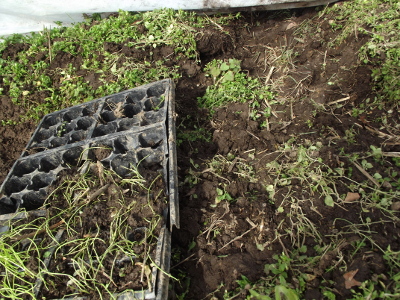
I've
tried to explain no-till
gardening to our
dog, but I just don't thinks she gets it. Last week, she tore up
a dozen beds in the mule garden, even breaking into the quick
hoops to continue
her vole hunt. She wreaked havoc on our young
onion beds, broke
the flats containing the extra transplants, but at least left me enough
living seedlings to replace her casualties.
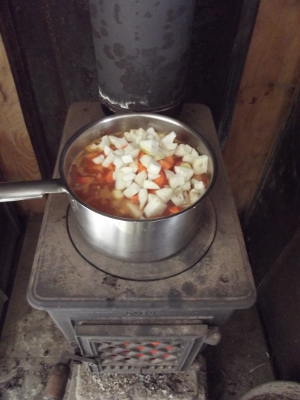 People
always say that the hardest folks to convert are your own family, so I
guess it's no surprise Lucy won't practice what I preach. At
least I found the uprooted turnips while most of them were still edible
enough to toss into a pot of lentil stew.
People
always say that the hardest folks to convert are your own family, so I
guess it's no surprise Lucy won't practice what I preach. At
least I found the uprooted turnips while most of them were still edible
enough to toss into a pot of lentil stew.
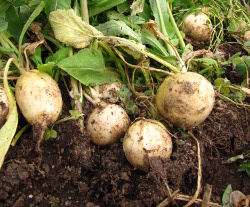
And, heck, now I know
that I don't need a pig if I ever want colonizer
livestock. I
can just turn Lucy into the paddock with a few rodents and watch the
dirt fly.
The first round of chicks
have out grown their blue Rubbermaid tub and graduated to the
new mini
coop.
Sometimes I wonder if a fake
mother hen would make new born chicks feel more secure in the first few
weeks when life is so dangerous and big.
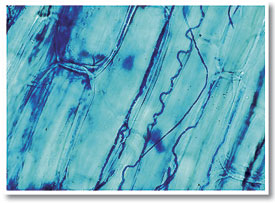 Most pasture farmers know
that endophytes are hard on animals, causing problems ranging from
pregnancy issues to staggers. Other ailments include slow growth,
hoof gangrene, and a hard time handling hot weather. But what are
endophytes?
Most pasture farmers know
that endophytes are hard on animals, causing problems ranging from
pregnancy issues to staggers. Other ailments include slow growth,
hoof gangrene, and a hard time handling hot weather. But what are
endophytes?
If you're a ryegrass or
fescue plant, endophytes are the coolest thing since sliced
bread. These symbiotic fungi --- Neotyphodium coenophialum in fescue and Neotyphodium
lolii in ryegrass
--- spend their whole lives inside a single grass plant, eating sugars
the plant hands over willingly. In exchange, the endophytes
produce alkaloids that deter insects and keep grazers like deer, sheep,
cattle, and horses from gorging too much on the grass.
When
scientists discovered the dangers posed by endophytes, they got to work
breeding endophyte-free grasses. However, they soon learned that
plants share their sugars with endophytes for a reason --- without the
endophytes, fescue and ryegrass tend to die out 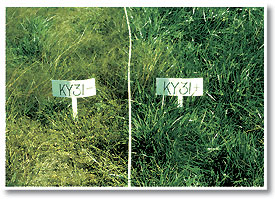 quickly. (The paired
photos show an ailing stand of endophyte-free fescue on the left and a
thriving stand of endophyte-infected fescue on the right.) Now
scientists have changed their tactics and are trying to breed
endophytes that produce the alkaloids that keep bugs at bay (peramine)
without making ergovaline (which is the most problematic alkaloid for
livestock). If you haven't planted a special (read: expensive)
strain,
though, chances are your ryegrass and fescue are infested with the
common endophyte varieties.
quickly. (The paired
photos show an ailing stand of endophyte-free fescue on the left and a
thriving stand of endophyte-infected fescue on the right.) Now
scientists have changed their tactics and are trying to breed
endophytes that produce the alkaloids that keep bugs at bay (peramine)
without making ergovaline (which is the most problematic alkaloid for
livestock). If you haven't planted a special (read: expensive)
strain,
though, chances are your ryegrass and fescue are infested with the
common endophyte varieties.
Luckily, you can work
around endophytes in many situations, giving your grasses the boost
they need to thrive without hurting your livestock's health. The
trick is to understand the life cycle of an endophyte-infected grass.
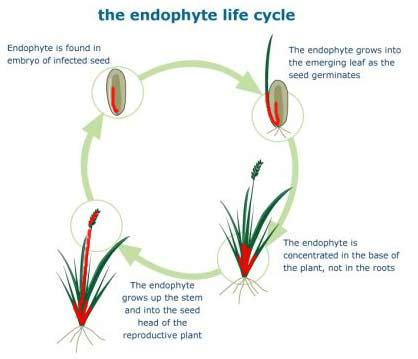 The red lines in this diagram
show the general location of endophytes within a plant. (No, you
can't actually see anything with your naked eye.) The fungus
comes along for the ride when a seed drops off the parent plant,
spreads up into the lower portion of the leaves, and then heads up the
flower stalk to infect new seeds.
The red lines in this diagram
show the general location of endophytes within a plant. (No, you
can't actually see anything with your naked eye.) The fungus
comes along for the ride when a seed drops off the parent plant,
spreads up into the lower portion of the leaves, and then heads up the
flower stalk to infect new seeds.
As a pasture maintainer,
this life cycle tells you how to ensure your livestock don't munch on
too much of the problematic fungus. If you don't overgraze your
pastures and do graze often enough that the grasses don't want to go to
seed, your livestock probably won't get enough endophyte into their
systems to cause problems. No wonder endophyte-related illnesses
tend to show up in summer or fall, when our cool season grasses are
declining and we're forced to graze them down to nubbins.
My final
endophyte-related question was --- do endophytes harm chickens? A
quick search of the internet doesn't turn up much definitive
information. Chickens fed on a diet of endophyte-infected fescue
seeds did worse than those fed on a diet of endophyte-free fescue
seeds, but other sources suggest that, in the wild, chickens don't eat
enough grass to get sick. Fescue is generally too tough for
chickens to digest, but I did plant some annual
ryegrass in one of
our pastures since these tender leaves are supposed to be much more
palatable to non-ruminants. I'll make sure to treat the ryegrass
carefully and will let you know if I see any problems.
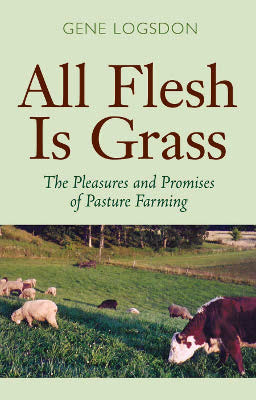 Gene Logsdon's All
Flesh is Grass
doesn't quite bring rotational grazing to the backyard, but the
author's focus on people with 2 to 100 acres who are growing meat for
personal consumption makes his ideas accessible to the average
homesteader. Don't get me wrong --- the intense information in Greener
Pastures on Your Side of the Fence and in Greg
Judy's mob grazing workshop were invaluable as I
continue to plan our pasturing setup, but it's also helpful to hear
from someone farming on a much smaller scale.
Gene Logsdon's All
Flesh is Grass
doesn't quite bring rotational grazing to the backyard, but the
author's focus on people with 2 to 100 acres who are growing meat for
personal consumption makes his ideas accessible to the average
homesteader. Don't get me wrong --- the intense information in Greener
Pastures on Your Side of the Fence and in Greg
Judy's mob grazing workshop were invaluable as I
continue to plan our pasturing setup, but it's also helpful to hear
from someone farming on a much smaller scale.
What does Logsdon's
pasture setup look like? His 32 acre farm in northern Ohio has
about 15 acres devoted to pasture, on which he raises cows, sheep, and
chickens for his family. The farm is divided into seven paddocks,
each of which is about two acres in size, and he lets livestock spend
about three weeks in each area before rotating them to the next paddock
in line. (Yes, it
is suboptimal to keep your livestock in a paddock for more than six days, but sometimes the
homesteader doesn't need to reach peak efficiency if he wants to keep
his sanity.)
Most of Logsdon's
pastures are a permanent mixture of bluegrass, ryegrass, white clover,
and tall fescue. However, he also rotates a few paddocks through
annuals (and short-lived perennials) like red clover, wheat, corn,
alfalfa, timothy, and ladino clover. Using all of these pasture
plants, Logsdon is able to start his animals on pasture in late March
and keep them there until they finish eating the stockpiled
grass in January or
February. Since he plans calving and lambing around the pasture
year, selling or eating meat animals in December, he has relatively few
livestock to feed during the nonpasture month(s).
This week's lunchtime
series will walk you through Logsdon's operation in more depth. I
highly recommend his book for the firsthand information on plant
polycultures, but have to warn you that if you have little patience for
pseudoinformation, you should skip
over the anecdotes that make up the chapters on individual types of
animals. I got bogged down in the sheep chapter for about three
months before plodding on through to the intriguing tidbits in the
second half of the book.
| This post is part of our All Flesh is Grass lunchtime series.
Read all of the entries: |
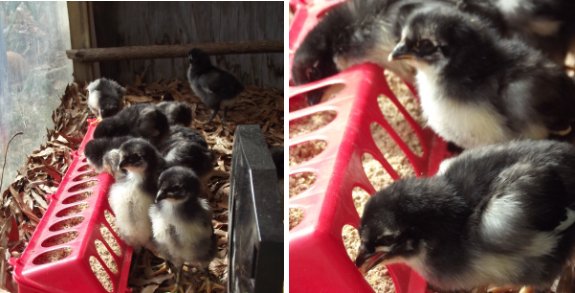
Chicks will stand in their
food dish if given the opportunity.
We've experienced this year after year, but always had bigger problems
to solve and payed the price by just adding more feed when they
scratched their way to the bottom of the dish.
This new automatic chick feeder seems to be big enough for our flock,
and so far none of them have figured out how to climb inside.
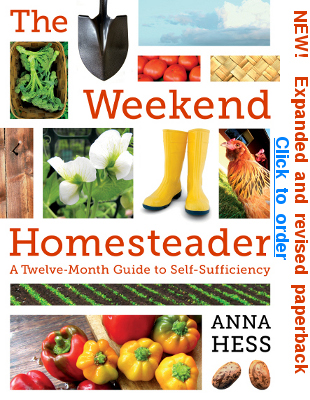 I figured that since Weekend
Homesteader is all grown up and ready to go into print, she deserved
her own page. Those of you who want to hear the blow by blow, be
sure to subscribe to the RSS feed.
I figured that since Weekend
Homesteader is all grown up and ready to go into print, she deserved
her own page. Those of you who want to hear the blow by blow, be
sure to subscribe to the RSS feed.
Meanwhile, I probably won't be blogging over here about Weekend
Homesteader until I have books in my hand. But I couldn't help
sharing the cover.
What do you think? I'm conflicted,
but I figure the publisher knows much more about covers than I do, so I
agreed to let it go to press as is.
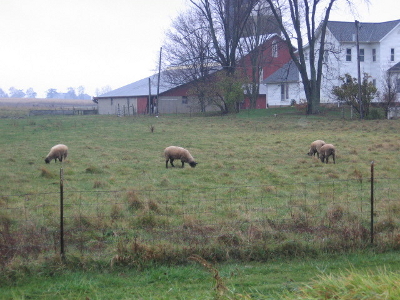 One of my favorite parts of All Flesh
is Grass is
Logsdon's fencing advice. Every other book and blog I've read
about rotational grazing sings the praises of temporary electric
fences, but Logsdon and I both aren't
fans of electric fences.
One of my favorite parts of All Flesh
is Grass is
Logsdon's fencing advice. Every other book and blog I've read
about rotational grazing sings the praises of temporary electric
fences, but Logsdon and I both aren't
fans of electric fences.
Logsdon started out his
operation with woven wire fences, mostly because he found a lot of free
materials. He uses heavy wooden posts that are nearly eight feet
long, driven two and a half to three feet in the ground and separated
by fifteen feet along the fenceline. As an old-fashioned farmer,
he likes posts he can cut himself --- red cedar, black locust, catalpa,
osage-orange --- but he will also split old electric poles or
railroad ties into thinner sections to use as fenceposts. His
corner posts are eight inch in diameter treated lumber, nine feet long,
sunk four feet into the ground, and braced. After pulling the
woven wire taut between these fence posts (and, yes, I was exhausted
before I even got to that part of the description), Logsdon adds a
strand of electric fence over top of the woven wire as a final line of
defense.
All of that said,
Logsdon is now changing over to livestock panels. These four foot
tall and sixteen feet long fence sections can be used on uneven
terrain, don't collapse if a tree limb falls on them, are modular and
easy to replace piecemeal, and are rated to last twice as long as woven
wire fences (for twice the price, of course). Installation is
easy --- just set a post every eight feet, with panels overlapping two
inches at the each end. After a year of closing up the holes Lucy
made in our chicken wire fences (and watching Mark swear as he tried to
stretch the fences up hills), I'm wishing we'd gone the livestock panel
route as well. Maybe for our next fences!
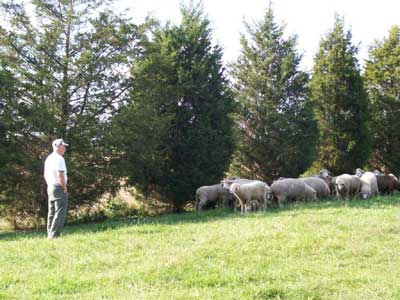 While we're on the topic of
fencing, I should add that one benefit of permanent fences is that you
can plant trees long the fenceline, adding another layer of
productivity to the pasture while making animals less likely to break
through. Logsdon has tried many different types of trees and
sings the praises of apples and peaches (both grown from seed), pears,
thornless honey locusts, and chinquapin oaks for
providing extra food for livestock. Red cedars make a good
windbreak and don't taste good to livestock, so you don't have to fence
the animals away from the young trees as carefully, plus you can use
them to make fence posts.
While we're on the topic of
fencing, I should add that one benefit of permanent fences is that you
can plant trees long the fenceline, adding another layer of
productivity to the pasture while making animals less likely to break
through. Logsdon has tried many different types of trees and
sings the praises of apples and peaches (both grown from seed), pears,
thornless honey locusts, and chinquapin oaks for
providing extra food for livestock. Red cedars make a good
windbreak and don't taste good to livestock, so you don't have to fence
the animals away from the young trees as carefully, plus you can use
them to make fence posts.
On the other hand,
Logsdon has tried some trees he wouldn't plant in a pasture
again. Weeping willows and black walnuts love to drop limbs all
over the fenceline, black locust leaves are toxic to animals, and
cherries not only have poisonous leaves, they also don't make very
tasty fruits if grown from seed. In addition, even if you plant
the best-behaved 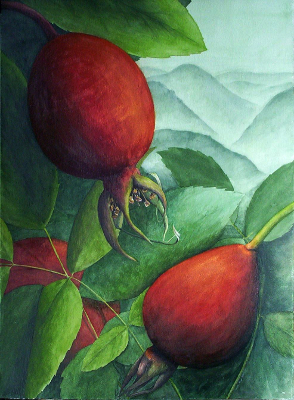 trees,
you'll need to spend a day every year cutting out grapevines, poison
ivy, and tree seedlings growing along your fencerow, but you'd spend
the same time weed-eating if you didn't have trees.
trees,
you'll need to spend a day every year cutting out grapevines, poison
ivy, and tree seedlings growing along your fencerow, but you'd spend
the same time weed-eating if you didn't have trees.
I've always liked the
idea of turning fencelines into productive zones, but with our small
pastures, trees are out of the question. However, when I bought
the scionwood
for our pear tree, I
threw in a couple of shrubs that are supposed to make good, thorny
hedges while providing edibles for chickens --- Rosa
rugosa and
Siberian pea shrub. Meanwhile, the timber
bamboo (Phyllostachys
vivax) that I
planted last year seems to be holding its ground. Maybe in
another five years or so, our fences will be lost in a sea of edible
and beautiful greenery.
| This post is part of our All Flesh is Grass lunchtime series.
Read all of the entries: |
Quick
hoop protection no longer needed?
We're crossing our fingers,
but at the same time we'll keep the hoops up and the Agribon material handy just in case.
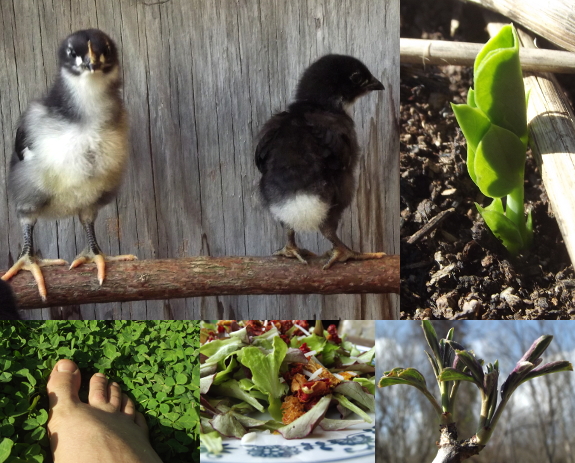
I let spring creep up on
us without telling you. The elderberry leaves have been poking
out of their buds for weeks now (although not getting terribly far),
and I noticed the first 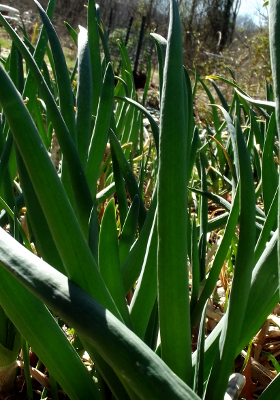 peas
slipping up through the soil last week. Meanwhile, the Egyptian onions are growing so fast my
frequent cuttings become invisible by the next day.
peas
slipping up through the soil last week. Meanwhile, the Egyptian onions are growing so fast my
frequent cuttings become invisible by the next day.
We also started eating
the first spring lettuce, but it wasn't quite as much of an event as
usual since we've been enjoying homegrown salads all winter. It
is fun to switch our salad greens from primarily kale to lettuce,
though, since that frees up the greens for sauteing.
I saw blooming spring
beauties and spicebushes (not pictured) while walking Lucy Tuesday, but
the real event was ground dry enough (in spots) to wander around
barefoot. With beautiful weather dominating the 10 day forecast,
I can't help but wonder if the floodplain might not become passable in
a week or two.
 The rest of this week's
lunchtime series is an overview of forage plants that match the three
pasture seasons --- spring/fall (this post), summer, and winter.
You should keep in mind that specifics like this are very location
specific, so if you live in the Deep South or in another area where
warm season (rather than cool season) grasses dominate, you should take
everything I write with several grains of salt. The closer you
live to Gene Logsdon's home base in northern Ohio, the more likely his
suggestions are to fit your pasture like a glove.
The rest of this week's
lunchtime series is an overview of forage plants that match the three
pasture seasons --- spring/fall (this post), summer, and winter.
You should keep in mind that specifics like this are very location
specific, so if you live in the Deep South or in another area where
warm season (rather than cool season) grasses dominate, you should take
everything I write with several grains of salt. The closer you
live to Gene Logsdon's home base in northern Ohio, the more likely his
suggestions are to fit your pasture like a glove.
In Logsdon's (and our)
location, spring is when pasture plants are at their peak, with a
lesser peak ocurring in the fall. You'll plan your meat animals
to match these peaks and (if your operation is big enough) will also
use the extra growth to make hay (or stockpiled
grass) for the
winter. So what do you plant in those spring/fall paddocks?
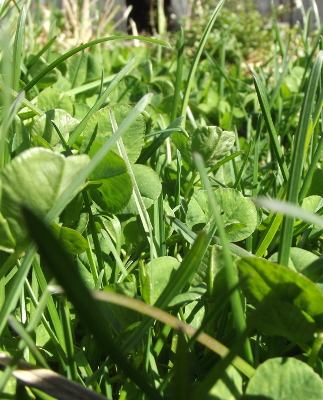 Logsdon makes a good case for
not planting at all. His experience (and mine) has been that if
you open up the tree canopy and mow close to the ground regularly, bluegrass will eventually dominate
your pastures. You might or might not need to plant the white
clover that works
so well to round out the pasture polyculture.
Logsdon makes a good case for
not planting at all. His experience (and mine) has been that if
you open up the tree canopy and mow close to the ground regularly, bluegrass will eventually dominate
your pastures. You might or might not need to plant the white
clover that works
so well to round out the pasture polyculture.
A less permanent
alternative is to plant ryegrass in the place of the
bluegrass that springs up naturally. Ryegrass is a bit taller
than bluegrass, so it may shade out your white clover (unless you seed
specially formulated clover varieties that can handle the more
aggressive grass), and even the perennial ryegrass versions need to be
reseeded at intervals. On the other hand, ryegrass might make up
for the extra effort since it produces more dry matter per acre than
bluegrass does and establishes quickly. Both bluegrass and
ryegrass are among the most palatable grasses in most livestocks'
estimation, but ryegrass
is often infected with an endophyte.
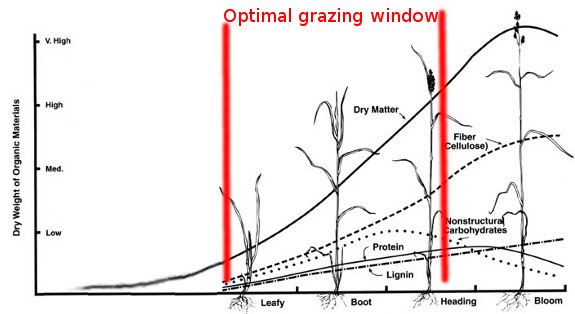 Ryegrass and bluegrass are
managed about the same. As I learned the hard way last year, you
need to graze or mow them hard and repeatedly in the spring and early
summer so they don't go to seed, since fruit production makes the
grasses less palatable and slows their growth considerably. You
can graze the pasture down to one inch, then let the grass regrow to
four to six inches before turning your animals back in. This
happens pretty quickly in the spring, and is one of the advantages of
short grasses.
Ryegrass and bluegrass are
managed about the same. As I learned the hard way last year, you
need to graze or mow them hard and repeatedly in the spring and early
summer so they don't go to seed, since fruit production makes the
grasses less palatable and slows their growth considerably. You
can graze the pasture down to one inch, then let the grass regrow to
four to six inches before turning your animals back in. This
happens pretty quickly in the spring, and is one of the advantages of
short grasses.
Drought, more than heat,
is what prevents bluegrass and ryegrass from barreling on through the
summer, so Logsdon suggests that it might be worth your while to
irrigate your pastures to keep them productive. I noticed that
the paddocks directly downhill from my oft-watered vegetable garden did
much better last summer than grasses in other areas.
Although bluegrass and
ryegrass aren't really winter grasses, you can let them grow in the
fall to stockpile forage for the winter. Logsdon notes that the
dense root structure of the bluegrass/clover sod prevents major damage
when smaller livestock are turned into the pasture in wet weather, and
he finds that the disturbed soil in hoofprints actually helps clover
gain more of a foothold. Stay tuned for later posts detailing
summer and winter alternatives to the bluegrass/clover pasture.
| This post is part of our All Flesh is Grass lunchtime series.
Read all of the entries: |
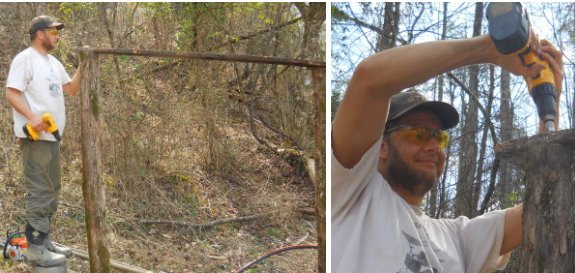
I'm starting a new
Appalachian myth.
A garden
gate built on Pi day will be magically impervious to deer.
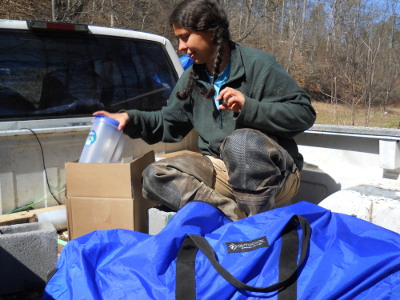 In a perfect world, I'd mulch
my vegetable garden with straw and my woody perennials with well
composted wood chips (or maybe leaves). If I needed to lay down a
kill mulch, I'd use corrugated cardboard as the kill layer. (Weekend
Homesteader: July gives the science behind these choices, but the
short version is --- it just makes the plants happy.)
In a perfect world, I'd mulch
my vegetable garden with straw and my woody perennials with well
composted wood chips (or maybe leaves). If I needed to lay down a
kill mulch, I'd use corrugated cardboard as the kill layer. (Weekend
Homesteader: July gives the science behind these choices, but the
short version is --- it just makes the plants happy.)
But we don't live in a
perfect world. Even though I'd been carrying in cardboard from
the parking area for a week, I managed to use up every lick of the
delicious kill mulch 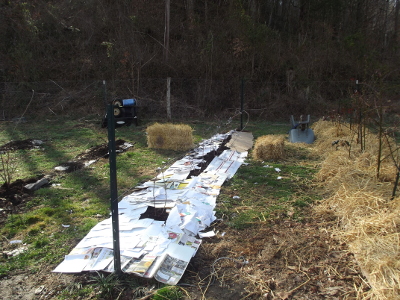 material in one busy
Tuesday. Plus, I'd already mulched with the leaves my mother
snagged on her city curb and didn't want to spend all afternoon raking
more out of the woods.
(The piles of
wood chips at our
parking area are mellowing very nicely, but no way am I carrying that
heavy organic matter in by hand.)
material in one busy
Tuesday. Plus, I'd already mulched with the leaves my mother
snagged on her city curb and didn't want to spend all afternoon raking
more out of the woods.
(The piles of
wood chips at our
parking area are mellowing very nicely, but no way am I carrying that
heavy organic matter in by hand.)
So, having run out of my
favorite mulches, I used...whatever. Wednesday found me laying
down kill mulches alongside the black raspberries
with junk mail and then topping it all off with straw. Yes, I've
had mixed
results with paper
in the past, but I figure woody 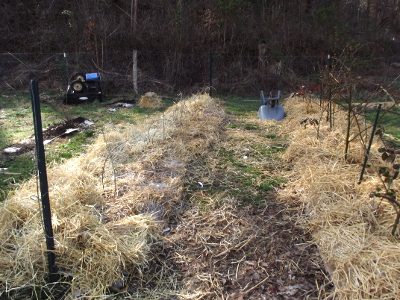 perennials
can handle the high carbon material better than a vegetable garden
could, and I also carefully pulled out all the slick pages (although I
left some colored newsprint in). I figure the high nitrogen straw
will help counteract the high carbon kill mulch (and will add nitrogen
to the soil this summer as the straw rots, making up for the fact that
I skimped a bit on manure --- we're running out of that too).
perennials
can handle the high carbon material better than a vegetable garden
could, and I also carefully pulled out all the slick pages (although I
left some colored newsprint in). I figure the high nitrogen straw
will help counteract the high carbon kill mulch (and will add nitrogen
to the soil this summer as the straw rots, making up for the fact that
I skimped a bit on manure --- we're running out of that too).
On the plus side, many
gardeners believe that it's a good idea to change your mulch and
compost source every year so your garden never gets overloaded (or
deficient) in one nutrient. So maybe I should be telling you I
thought all this through and decided a year under straw would make the
soil in our berry patch more well-rounded? Naw --- that's too
much like bright
yellow boots.
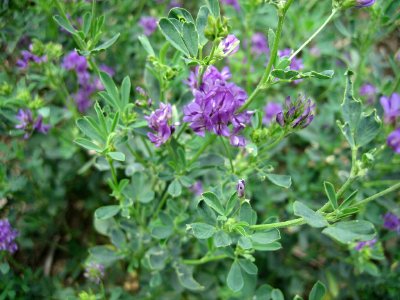 Bluegrass
or ryegrass with white clover makes a great spring and fall
pasture, but where do you put your hungry critters during the summer
slump? Gene Logsdon offers a slew of possibilities, ranging from
semi-perennial legumes to warm season grasses and even weeds.
Bluegrass
or ryegrass with white clover makes a great spring and fall
pasture, but where do you put your hungry critters during the summer
slump? Gene Logsdon offers a slew of possibilities, ranging from
semi-perennial legumes to warm season grasses and even weeds.
In his own pasture
setup, Logsdon focuses on alfalfa, red clover, and ladino clovers to
fill in the summer lull, planting these short-lived perennial legumes
in rotation with winter crops like grains. When choosing one of
these legumes, keep in mind that alfalfa is the most drought tolerant
and produces more biomass than any other legume if it's happy, but that
it hates clay and can't be planted 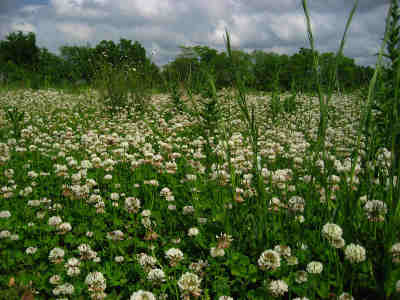 in the same spot for several years after the
stand dies out. Red clover outperforms alfalfa on heavy
soils and in cold, moist climates, finding favor in the Corn Belt, the
Northeast, and the mid-South. Ladino
clover is the
most palatable of these tall legumes and can handle heavy, wet soil,
but produces less hay per acre, won't survive drought, and requires
reseeding most often.
in the same spot for several years after the
stand dies out. Red clover outperforms alfalfa on heavy
soils and in cold, moist climates, finding favor in the Corn Belt, the
Northeast, and the mid-South. Ladino
clover is the
most palatable of these tall legumes and can handle heavy, wet soil,
but produces less hay per acre, won't survive drought, and requires
reseeding most often.
All three legumes are
managed about the same. In the Deep South, red and ladino clovers
are grown as annuals, but elsewhere the legumes are perennials that
should be surface seeded in winter, then given several months to get
established. You can begin to cut or 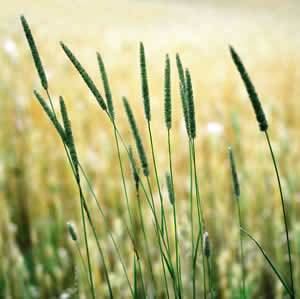 graze once the plants begin
to bloom, then continue to cut or graze at the same stage until
September, at which point the plants must be allowed to put on some
mass so they will survive the winter.
graze once the plants begin
to bloom, then continue to cut or graze at the same stage until
September, at which point the plants must be allowed to put on some
mass so they will survive the winter.
Timothy can be mixed with the
legumes (especially red clover), but if you combine the plants, it's
best to gauge grazing or cutting time by the legume since timothy grows
more slowly. Orchardgrass is sometimes mixed with
alfalfa in the lower Corn Belt and mid-South, but the grass becomes
unpalatable quickly in the spring if you're not careful. Finally,
smooth
bromegrass is
often combined with alfalfa in the North since the grass and legume
have similar drought resistance.
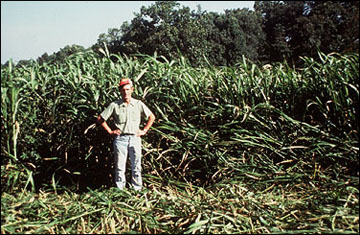 At the other end of the
country, you might consider planting a paddock or two to warm season
grasses for the summer months. Quackgrass, crabgrass, and foxtail are weeds that spring up all
by themselves in cultivated ground, while bermudagrass (also a weed by many folks'
estimation) will take over in the Deep South. Sorghum-sudangrass
hybrid is often
planted for high production pastures in midsummer, but the leaves are
toxic when less than a foot tall, which gives the plant limited utility
for grazers like chickens who like tender forage. Although a
legume instead of a grass, lespedeza is a possibility in the
South, but can be a problem weed that becomes unpalatable if not
managed carefully.
At the other end of the
country, you might consider planting a paddock or two to warm season
grasses for the summer months. Quackgrass, crabgrass, and foxtail are weeds that spring up all
by themselves in cultivated ground, while bermudagrass (also a weed by many folks'
estimation) will take over in the Deep South. Sorghum-sudangrass
hybrid is often
planted for high production pastures in midsummer, but the leaves are
toxic when less than a foot tall, which gives the plant limited utility
for grazers like chickens who like tender forage. Although a
legume instead of a grass, lespedeza is a possibility in the
South, but can be a problem weed that becomes unpalatable if not
managed carefully.
Corn isn't exactly a pasture
plant, but Logsdon suggests a method to work the grain into your
pasture rotation without harvesting any of the ears yourself. You
can turn lambs into the pasture to eat the lower leaves and weeds when
the corn is above their heads, then replace them with hogs who harvest
the grain when the plants are mature. Finally, sheep and cows
munch on the fodder (and dropped ears of corn) over the winter.
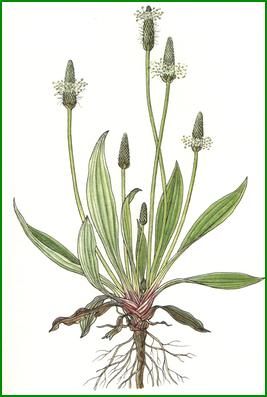 In his chapter on weeds,
Logsdon tosses out the idea of a temporary ley for summer
pasture. Newman Turner's Fertility Pastures and Cover Crops recommends planting the
following combination for midsummer:
In his chapter on weeds,
Logsdon tosses out the idea of a temporary ley for summer
pasture. Newman Turner's Fertility Pastures and Cover Crops recommends planting the
following combination for midsummer:
- Alfalfa (6 pounds per acre)
- Chicory (6 pounds per acre)
- Timothy (6 pounds per acre)
- White clover (3 pounds per acre)
- Burnet (3 pounds per acre)
- Late-flowering red clover (2 pounds per acre)
- Meadow fescue (4 pounds per acre)
- Perennial ryegrass (12 pounds per acre)
- American sweet clover (2 pounds per acre)
- Sheep's parsley (2 pounds per acre)
- Carraway (1 pound per acre)
- Narrow-leaved plantain (1 pound per acre)
- Broad-leaved plantain (1 pound per acre)
Although Logsdon laughs
at the idea of finding seeds for notorious weeds like plantain, the
permaculturist might keep an eye on weedy spots for midsummer forage.
| This post is part of our All Flesh is Grass lunchtime series.
Read all of the entries: |
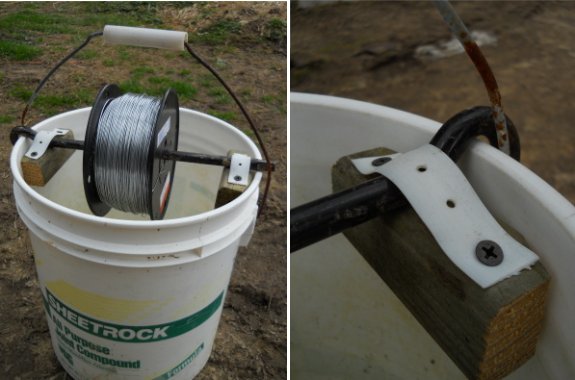
Our first roll of electric
wire lasted years, and all that time I was unrolling it wrong.
I started out thinking a 2x4
frame with a handle would work as a holder for today's brand new roll. I
was low on scrap wood, but got inspired when I saw an empty bucket in
the garden.
It can also be used to carry
wire cutters and the mini-sledge
hammer.
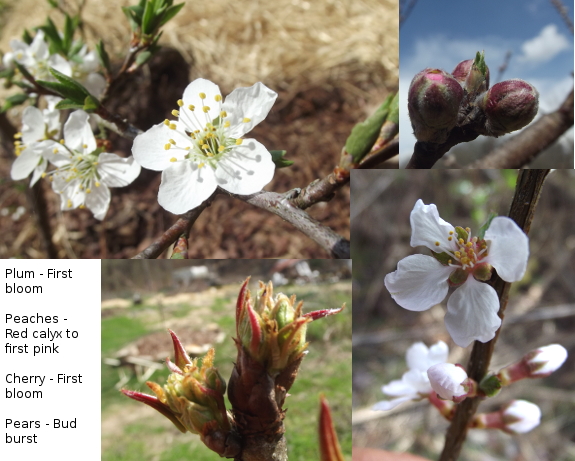
The first Nanking
cherry and plum
flowers opened on March 14, and the rest of our fruit trees aren't far
behind. Here's my best guess about when our orchard was in a
similar stage of bud break in previous years:
- March 23, 2009. (A late freeze wiped out all the blooms and
we didn't get any fruit.)
- April 3, 2010. (Great harvest of peaches!)
- March 22, 2011. (Would have been a great harvest of peaches if not for brown rot. We got two pears too.)
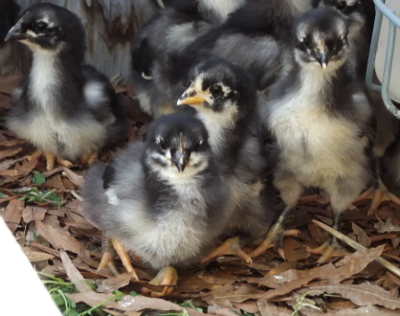 So, it looks like we're
running about a week or two early --- not as bad as I'd feared.
In fact, now might be a good time for the fruit trees to go ahead and
bloom since the ten day forecast looks like summer. We'll just
have to hope for no more freezes below the post-bloom critical
temperature of 28
for the rest of the season.
So, it looks like we're
running about a week or two early --- not as bad as I'd feared.
In fact, now might be a good time for the fruit trees to go ahead and
bloom since the ten day forecast looks like summer. We'll just
have to hope for no more freezes below the post-bloom critical
temperature of 28
for the rest of the season.
The other photos in this
post are totally unrelated. But I have a hard time not throwing
in gratuitous spring images. Enjoy!
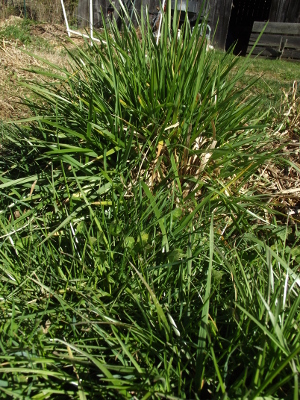 Winter
is the trickiest time to keep animals fed, but Logsdon offers enough
suggestions to fuel years of experimentation. First, there are
the basics --- stockpile
grasses for
ruminants so they can eat in the fields, spreading their manure as they
go. But if you want fresh winter food for your animals to harvest
on the hoof, there are other options as well.
Winter
is the trickiest time to keep animals fed, but Logsdon offers enough
suggestions to fuel years of experimentation. First, there are
the basics --- stockpile
grasses for
ruminants so they can eat in the fields, spreading their manure as they
go. But if you want fresh winter food for your animals to harvest
on the hoof, there are other options as well.
Although fescue is not one of the most
palatable grasses, Logsdon (and his buddy Bob Evans, of restaurant
fame) consider this grass the key to year-round grazing since it will
grow a bit even in the winter. This photo shows a clump of fescue
in my garden, amid our usual bluegrass --- you can tell that the fescue
got a jump start on spring and is already too tough for a chicken to
nibble on. To manage a fescue pasture, Logsdon suggests keeping
it short and tender with frequent cutting in the spring, and being
careful of the endophytes that can make certain
animals sick. He lets fescue and bluegrass grow together, mowing
closer if he wants to encourage the bluegrass and higher if he wants
the fescue to spread.
 Winter grains can provide
lots of winter forage as long as you don't mind cultivating the ground
and replanting every year. Logsdon mentions a recent study
in Ohio where oats were planted in August and
then strip grazed by cattle from November through March (with a few
weeks break in February when ice was too thick for the cows to break
through). Tender young oat leaves contain 20% protein, and our
chickens were willing to nibble on them once other greenery died back
last winter. Other winter grains have varying levels of
palatability and winter hardiness, but you might try wheat, barley, and rye as well.
Winter grains can provide
lots of winter forage as long as you don't mind cultivating the ground
and replanting every year. Logsdon mentions a recent study
in Ohio where oats were planted in August and
then strip grazed by cattle from November through March (with a few
weeks break in February when ice was too thick for the cows to break
through). Tender young oat leaves contain 20% protein, and our
chickens were willing to nibble on them once other greenery died back
last winter. Other winter grains have varying levels of
palatability and winter hardiness, but you might try wheat, barley, and rye as well.
Roots like turnips, rutabagas, parsnips, mangels, and sugar beets fill the niche of corn
(providing lots of carbohydrates), but are generally more expensive to
grow. The positive side of roots is that you can sometimes plan
them so that the animals harvest the roots right out of the
field. Turnips and rutabagas are best for winter harvesting since
the roots stick out of the ground some, while hogs will harvest sweet
potatoes earlier in the year.
However, roots do have
their problems as winter forage for livestock. They're all very
watery, so animals have to eat a lot to get the same amount of energy
they'd get from grains --- it takes four bushels of sweet potatoes to
equal the nutritional value of one bushel of corn, and other roots are
even worse. Roots also tend to cause diarrhea in some animals if
fed fresh in the field, and all but mangels and sugar beets change the
flavor of milk. Bob  Evans feeds his livestock 75%
turnips and 25% stockpiled grass to work around some of the issues with
roots.
Evans feeds his livestock 75%
turnips and 25% stockpiled grass to work around some of the issues with
roots.
The final option for
non-grain winter feed is leafy greens. Crucifers like kale, rape, kohlrabi, and cabbage are all eaten happily by
sheep, while chickens love Swiss chard. Our chickens seemed
to prefer the mustard
greens we sowed
along with oats in our experimental winter pasture over the
grain. And although Austrian
winter peas have
a big following, our flock turned up their noses at the overwintering
legumes.
Are there winter pasture
options you use that I didn't mention here? I hope you'll leave a
comment and share your wisdom.
| This post is part of our All Flesh is Grass lunchtime series.
Read all of the entries: |
The experimental
mini-enclosure for our
new chick coop is retired for now.
We were planning on using it
to capture some heat from the Eco-Glow brooder in case the
night time temperature dropped below 50.
Turns out the big, green,
plastic tub was too scary for our chick's first day. Just a few went
under it, and they only stayed for a brief moment before scooting back
to the bunched up flock in the corner. Maybe a small night light would
make it look more cozy? Now that they're older it's not as big of an
issue and the weather forecast calls for warm nights in the near future.
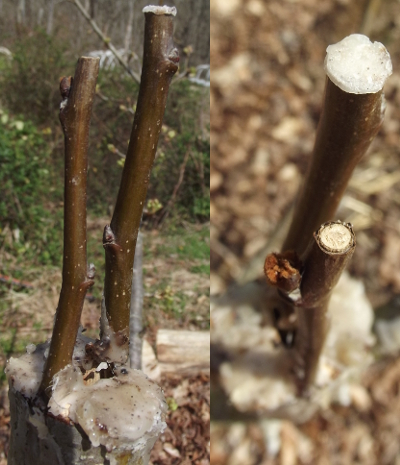 I
decided to take the plastic
bags off my pear
grafts since it's been getting so hot I was afraid the scionwood
would cook. The beeswax has done a remarkably good job of staying
put...except for on top of one of the four pieces of scionwood. I
thought I might have just missed that spot when initially dabbing on
the wax, but photographic evidence is to the contrary.
I
decided to take the plastic
bags off my pear
grafts since it's been getting so hot I was afraid the scionwood
would cook. The beeswax has done a remarkably good job of staying
put...except for on top of one of the four pieces of scionwood. I
thought I might have just missed that spot when initially dabbing on
the wax, but photographic evidence is to the contrary.
There's quite a
difference in vibrancy between the scionwood that lost its cap and the
one that retained its cap. The former looks a bit shriveled up
and the bud appears to have tried to open and failed, while the
wax-capped twig looks plumper and content to wait until the rest of the
tree starts leafing out.
Hopefully one piece of
scionwood will be enough to change the variety on that pear. I
don't expect to see any growth for a month or two since grafted
scionwood often waits to wake up until after the rootstock has already
put out leaves. Stay tuned for further updates.
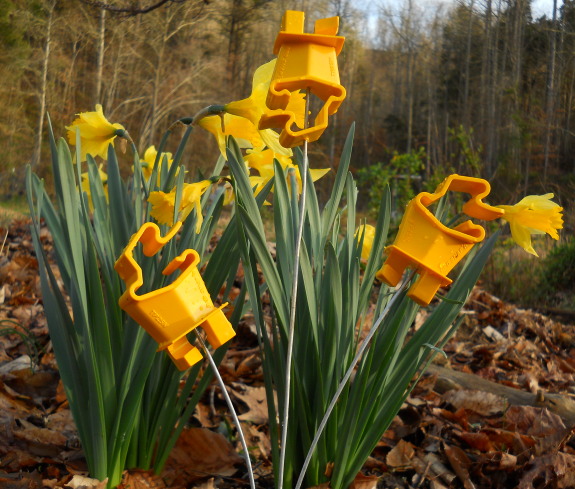
1. 3/32 drill bit
2. 14 gauge galvanized wire
3. yellow electric fence
insulators
4. warped sense of aesthetics
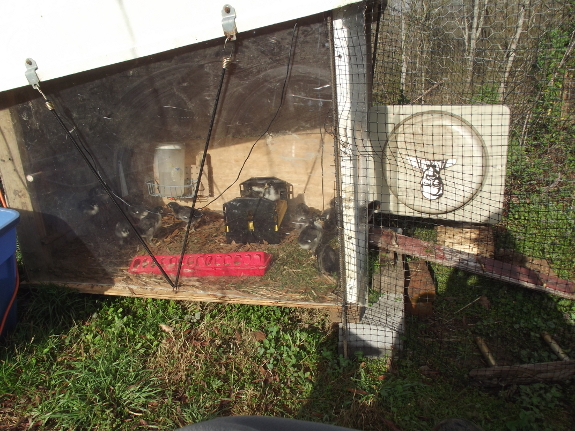
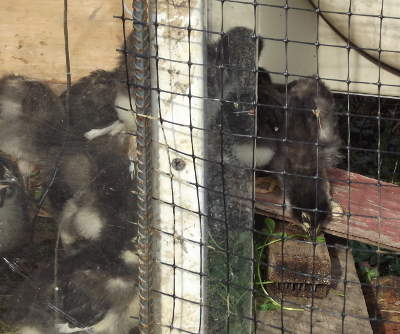 They don't call them chickens
for nothing.
They don't call them chickens
for nothing.
24 hours after I fenced
off an outdoor playpen for the
chicks, they were
still huddled around the doorway, drawing straws to decide who should
go first.
I cut off their fresh
greens deliveries, but sprinkled some clover on top of the ramp to tempt the chicks
closer. I had expected an Australorp to lead the way, so I was
surprised to find that a Marans/Australorp hybrid was the bravest.
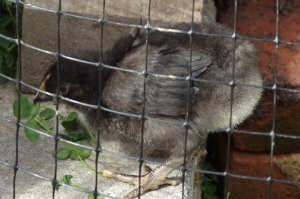 Once she hopped down onto the
ground a couple of times, of course, everyone else had to follow
suit. And they started grazing like cows!
Once she hopped down onto the
ground a couple of times, of course, everyone else had to follow
suit. And they started grazing like cows!
I don't think of
chickens as being able to digest excessive amounts of greenery, but our
Australorps continue to prove me wrong. I think that tender
spring growth, especially, is quite digestible even if you only have a
single stomach.
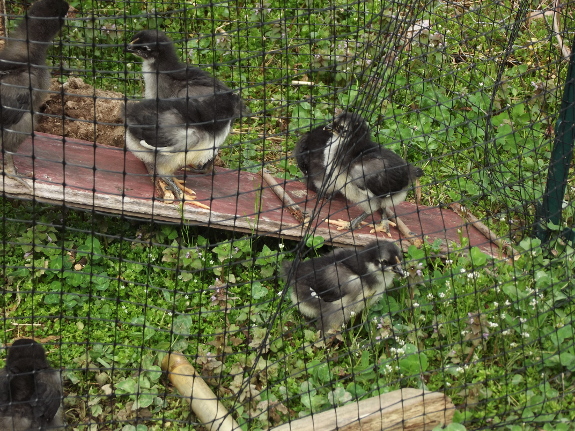
Looks like I'll need to
expand that playpen tomorrow or the next day.
Maybe by then, the chicks will be big enough that I can use our usual temporary
fencing material and
give them more room to play.
Our mechanic was able to
track down a used tailgate
at a local junk yard for only 100 bucks. 25 for delivery and another 25
for hammer adjustments and lubrication.
Anna thinks it looks like
just another tailgate, but for me it seems like an improvement. I know
the color doesn't match, but that shade of red has some sort of
emotional charge I can't seem to put my finger on. Maybe it's connected with that
scene in the original Matrix movie where a woman walks by in a red dress
during Neo's first self aware simulation?
There's hardly a scratch on
it, which implies it grew up with a silver spoon in its mouth and lived
a life of privilege not unlike our cat Huckleberry.
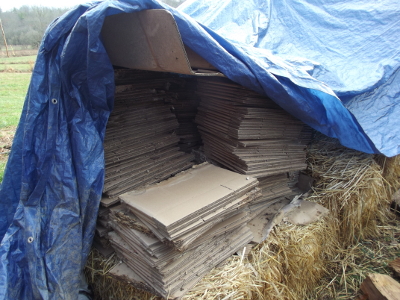 I
hardly know where to start telling you the story of the cardboard
motherlode. Mark was the one who found it, even though we were
both in the same room. My husband has developed quite a knack for
ferreting out biomass going to waste, so when our friends told us that
they were bringing a lot of cardboard boxes to the recycling center,
Mark's ears perked right up.
I
hardly know where to start telling you the story of the cardboard
motherlode. Mark was the one who found it, even though we were
both in the same room. My husband has developed quite a knack for
ferreting out biomass going to waste, so when our friends told us that
they were bringing a lot of cardboard boxes to the recycling center,
Mark's ears perked right up.
The story is a
bittersweet one of composting
old dreams, and made
me feel very lucky that we'd started our microbusiness and writing
ventures in the era
of the internet. The owner of the unwanted boxes is a writer who
had gone the semi-traditional self-publishing route decades ago.
He ordered thousands of copies of his books, enough to make it
worthwhile to get them printed, then a big truckload of cardboard boxes
to use when mailing the texts to customers.
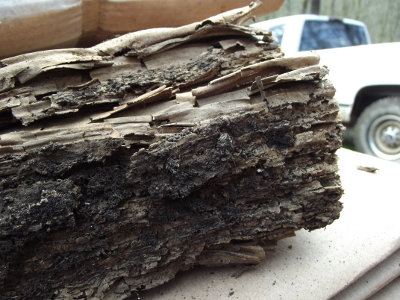 At that time, it wasn't
really possible to follow my microbusiness admonition to keep your
startup costs below $1,000 and not to fill your barn with inventory,
nor could our friend easily sell his books to a worldwide market at no
cost (except a per-book fee) on Amazon. I suspect he also didn't
really need the cash, and liked writing more than he liked marketing
his works --- having to go get a job in Kingsport if our
microbusinesses fail is a strong incentive to keep our noses to the
grindstone.
At that time, it wasn't
really possible to follow my microbusiness admonition to keep your
startup costs below $1,000 and not to fill your barn with inventory,
nor could our friend easily sell his books to a worldwide market at no
cost (except a per-book fee) on Amazon. I suspect he also didn't
really need the cash, and liked writing more than he liked marketing
his works --- having to go get a job in Kingsport if our
microbusinesses fail is a strong incentive to keep our noses to the
grindstone.
So the books sat in our
friend's office and the boxes moldered in his barn until Mark heard
about their planned journey to the recycler. The books were
already gone, but three huge bales of cardboard boxes were free for the
taking. They'd been sitting on the ground for years and some had
lost as much as half their mass into the soil, but most were perfect
kill mulch material.
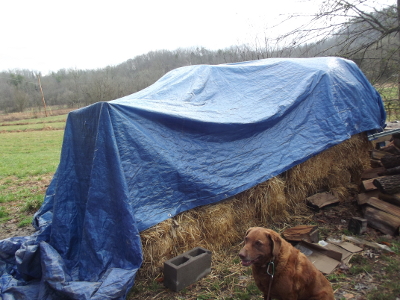 Some of the partially
degraded boxes had mycelium growing on them, which just supports my
hypothesis that corrugated cardboard is like candy for soil
microorganisms. I've been wondering lately whether Steve Solomon
is right to say that the glue is what makes cardboard so enticing, or
whether the answer is much simpler. Could the corrugations give
just the right amount of air space to keep the cardboard moist but
still well aerated, creating the perfect environment for fungal growth?
Some of the partially
degraded boxes had mycelium growing on them, which just supports my
hypothesis that corrugated cardboard is like candy for soil
microorganisms. I've been wondering lately whether Steve Solomon
is right to say that the glue is what makes cardboard so enticing, or
whether the answer is much simpler. Could the corrugations give
just the right amount of air space to keep the cardboard moist but
still well aerated, creating the perfect environment for fungal growth?
We've stockpiled the
cardboard with the straw at our parking area and I carry in a big
duffel bag full each time I walk Lucy. I'd like to say the
cardboard will feed my garden forever, but I figure it might last...two
weeks?
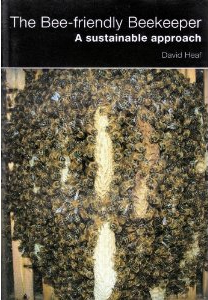 As regular readers know, I've
been pondering alternative beekeeping methods all winter. Both
of our hives (semi-traditional Langstroth) died last fall, so we're buying two
packages of chemical-free
bees to start over this spring. One package will go into a top bar hive courtesy of Everett, but I
haven't quite decided whether the other colony will go back into our
Langstroth hives (managed
in Michael Bush's style) or whether they'll go into
a Warre hive.
As regular readers know, I've
been pondering alternative beekeeping methods all winter. Both
of our hives (semi-traditional Langstroth) died last fall, so we're buying two
packages of chemical-free
bees to start over this spring. One package will go into a top bar hive courtesy of Everett, but I
haven't quite decided whether the other colony will go back into our
Langstroth hives (managed
in Michael Bush's style) or whether they'll go into
a Warre hive.
When I explained the differences
between Warre and top bar hives before, I said that the book
to read on Warre hives is Abbe Warre's Beekeeping
for All.
However, I ended up instead picking up a copy of David Heaf's The Bee-friendly Beekeeper. This modern book sums
up the experiments and innovations that have accumulated since the
Warre hive hit the English-speaking world in 2006. It has lots of
pretty pictures to make the text more understandable and is definitely
worth hunting down (even though it's expensive in the U.S. since the
book is British). The author is a bit preachy about
sustainability of materials and the book is short (referring you back
to Beekeeping
for All for more
information), but I like the way Heaf has clearly delved into the
scientific literature to find real facts about natural beekeeping.
Stay tuned for
information about the Warre hive all week in my lunchtime series.
Meanwhile, maybe you can help me decide whether it's crazy to try out
two new beekeeping methods at once, or whether it's an unparalleled
opportunity for a side by side comparison of horiztontal and vertical
top bar hives.
| This post is part of our Warre Hive lunchtime series.
Read all of the entries: |
It's been a full year since I
first posted about the chicken cam
project and I'm happy to report we've made some progress.
We're still working out some
of the technical details. Turns out the wireless feature is a bit
spotty, which we plan to fix with a long ethernet cable.
The webcam box will have a 5
gallon bucket lid for a roof so that it can extend out past the
plexiglass.
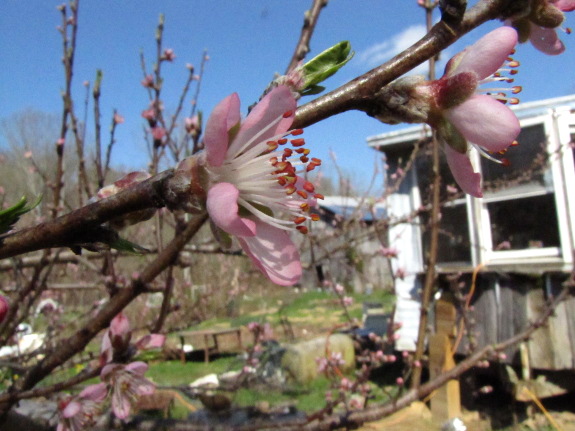
If you have the
opportunity to plant a peach tree right outside your kitchen window, I
highly recommend it. For the last few days, I've been torn
between watching chicken
TV and pollinator TV as we eat our meals, but I think I might
prefer the pollinators.
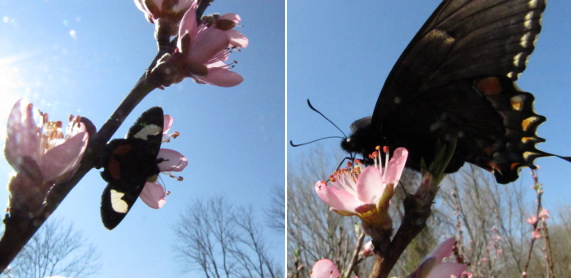
I can identify
butterflies, moths, greater
bee flies, honeybees, and bumblebees from a distance, but the
rest of the pollinators are too small for me to easily distinguish
unless I snap a photo to peruse inside. If you've got a lot of
tiny native bees you're itching to identify, I recommend flipping
through Attracting
Native Pollinators,
or asking for help at BugGuide.net.
Or you can just watch
the tiny pollinators buzz around your blooms and guess how many
different species are present. They work just as hard even if we
don't know who they are.
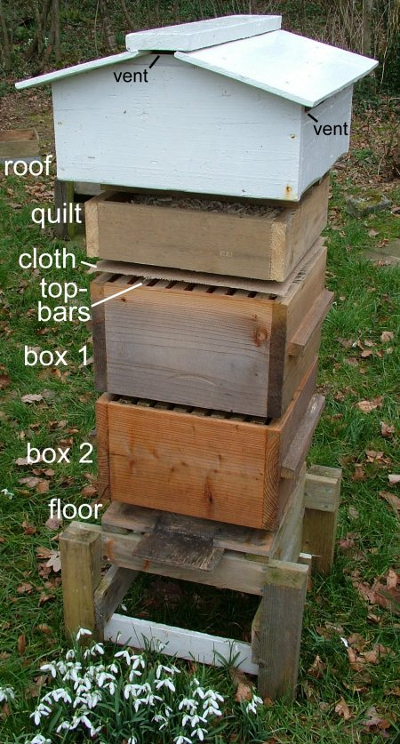 The Warre hive (sometimes
called the "vertical top bar hive") is named after a French abbot who
developed a simple hive that could easily be constructed by the common
Joe. On the surface, the hive looks a lot like the Langstroth
hives that are so common in the U.S., but the boxes are smaller, the
wood is thicker, and there's an insulated "quilt' and roof area.
In addition, beekeepers usually use top bars instead of framed
foundation.
The Warre hive (sometimes
called the "vertical top bar hive") is named after a French abbot who
developed a simple hive that could easily be constructed by the common
Joe. On the surface, the hive looks a lot like the Langstroth
hives that are so common in the U.S., but the boxes are smaller, the
wood is thicker, and there's an insulated "quilt' and roof area.
In addition, beekeepers usually use top bars instead of framed
foundation.
Even though the Warre
hive resembles the Langstroth hive, it is managed in a completely
different manner. Warre beekeepers believe that protection of the
natural heat and scent within the hive is of utmost importance, and
that every type of manipulation by the beekeeper requires the bees to
work harder to maintain the Nestduftwarmebindung. So beekeepers
refrain from rearranging combs (for example, to open
up the brood box)
since that moves scents around, and they strive not to take the top off
the hive more than once a year.
Despite what that last
sentence sounds like, Warre beekeepers don't ignore their bees all year
and then expect to harvest lots of honey. They understand that
the larger a hive is, the harder the bees have to work to keep out wax
moths and diseases, so they add extra boxes at intervals throughout the
spring and summer just like a Langstroth beekeeper would. The
difference is that they put the boxes on the bottom --- nadiring ---
which is achieved by hefting the whole hive upward using a pulley-based
hive lift. The bees barely notice the intrusion, and the
Nestduftwarmebindung stays in place within the hive.
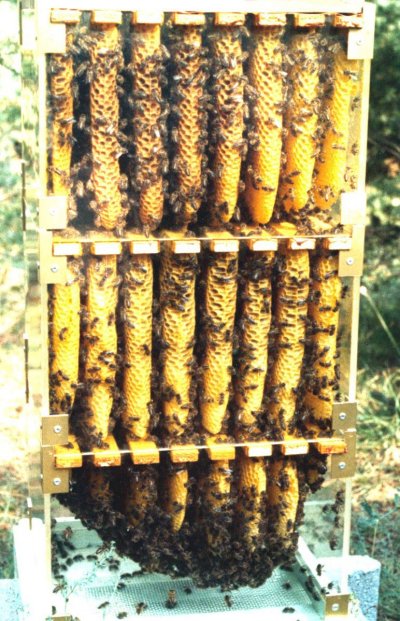 Throughout the year, Warre
beekeepers also spend a lot of time observing the hive to ensure that
all's well within. They listen to the hive, watch and smell at
the entrance, and even put their hand on the quilt that covers the top
box to estimate its warmth. Many beekeepers weigh their hives to
check on honey stores, and some Warre boxes have observation windows
(fitted within insulated shutters when not in use) to allow
non-intrusive viewing.
Throughout the year, Warre
beekeepers also spend a lot of time observing the hive to ensure that
all's well within. They listen to the hive, watch and smell at
the entrance, and even put their hand on the quilt that covers the top
box to estimate its warmth. Many beekeepers weigh their hives to
check on honey stores, and some Warre boxes have observation windows
(fitted within insulated shutters when not in use) to allow
non-intrusive viewing.
In the fall, the
beekeeper opens up the hive more fully for the first time. In the
past months, the bees have filled up box after box, naturally moving
their brood area into new boxes below and replacing brood above with
honey. The beekeeper is able to remove whole boxes of honey off
the top to crush
and strain, which is
the most intrusion the hive ever sees.
Here's the catch ---
Warre hives don't produce as much honey as Langstroth hives. In The
Bee-friendly Beekeeper,
David Heaf notes that you should expect only half as much honey from a
Warre hive as from a Langstroth hive, and Heaf insinuates that forcing
bees to make so much honey is one of the factors that leads to decline
of modern apiaries.
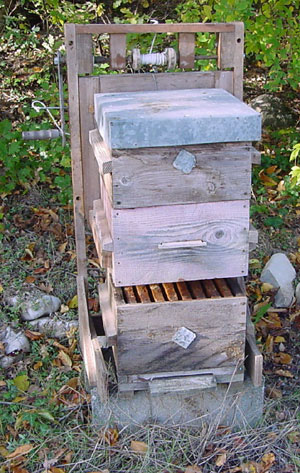 On the other hand, Heaf also
argues that Warre hives don't need as much honey to get them through
the winter due to the better thermal performance of the hive. He
leaves only 26 pounds of honey for his hives in the UK and says that,
in general, Warre hives need about 67% as much honey to overwinter as
Dadant hives do. (Dadant hives are related to Langstroth hives,
but have fallen out of favor.)
On the other hand, Heaf also
argues that Warre hives don't need as much honey to get them through
the winter due to the better thermal performance of the hive. He
leaves only 26 pounds of honey for his hives in the UK and says that,
in general, Warre hives need about 67% as much honey to overwinter as
Dadant hives do. (Dadant hives are related to Langstroth hives,
but have fallen out of favor.)
I'm very torn about the
idea of adding a Warre hive to our homestead, but not because of the
lower honey yields. On the one hand, the Nestduftwarmebindung
principle makes intuitive sense to me, especially once I read that a
hive can sometimes take three days to regain its temperature after
being opened and that cool temperatures in the hive can encourage pests
and diseases. On the other hand, I'm a nervous nellie, and can't
quite imagine not going through the brood nest at intervals to make
sure everything's okay. I'm also envisioning setting up a hive
lift wrong and ending up with bees spilled all over the ground, and
losing lots of swarms to the world since you can't manage reproduction
very well in the Warre hive. (More on that in a later post.)
On the third hand, it's
new, different, and intriguing. How could I resist?
